It seems we can’t find what you’re looking for. Perhaps searching can help.
Sign Up for newsletter!
Subscribe to get the latest eBook!
Hotline






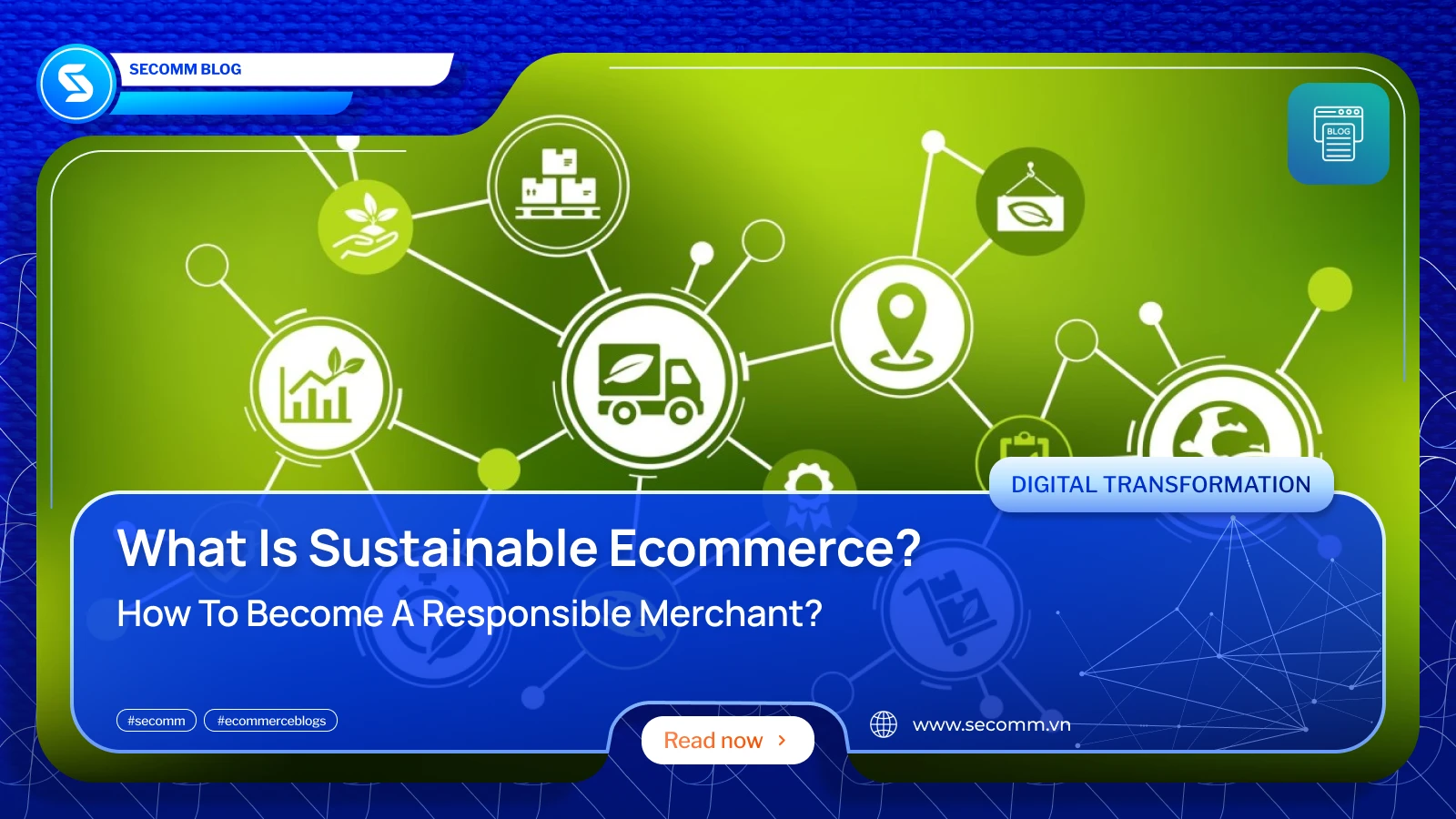
eCommerce has become an integral part of our daily lives, offering unparalleled convenience and access to a vast array of products. However, as the industry continues to grow, so does its environmental footprint. From excessive packaging waste to carbon emissions from shipping, the environmental impact of eCommerce cannot be ignored. This brings us to the concept of sustainable eCommerce—a transformative approach that seeks to minimize the negative environmental effects of online retail while promoting ethical business practices.
Sustainable eCommerce is not just a trend; it’s a response to the increasing consumer demand for environmentally friendly and socially responsible products. A survey shows that 72% of respondents reported that they were actively buying more environmentally friendly products than they did five years ago, while 81% said they expected to buy even more over the next five years.
In this blog, we will delve into the essence of sustainable eCommerce, explore its importance, examine the growing demand for it, and provide practical steps on how you can become a responsible merchant.
Sustainable eCommerce refers to the practice of conducting online business in a way that minimizes environmental impact and promotes social responsibility. At its core, it involves making mindful decisions at every stage of the business process, from product sourcing and manufacturing to packaging, shipping, and customer engagement. The goal is to reduce the carbon footprint, minimize waste, and ensure that ethical standards are upheld throughout the supply chain.
There are some common components in the eCommerce sustainability, including:
Offering products that are made from sustainable materials, are biodegradable, or have a lower environmental impact is crucial. This means choosing materials that are renewable, such as organic cotton or bamboo, over conventional materials that may deplete natural resources or cause pollution. Additionally, promoting products that are ethically sourced ensures that they are produced under fair labor conditions, respecting workers’ rights and contributing to social sustainability.
Sustainable packaging involves using materials that can be recycled, are biodegradable, or are made from recycled content. For instance, using cardboard boxes made from recycled paper or packing peanuts that are biodegradable can greatly reduce the environmental footprint. This approach not only minimizes waste but also appeals to environmentally conscious consumers.
Reducing energy consumption in the warehousing and logistics aspects of eCommerce is another critical component. This can be achieved by:
Minimizing waste throughout the entire eCommerce process is essential. This involves:
Ensuring that all business practices are ethical and transparent is fundamental to sustainable eCommerce. This includes:
By integrating these key components to strategies, eCommerce businesses can significantly reduce their environmental impact, support social responsibility, and meet the growing demand from consumers for more sustainable and ethical products.
Understanding the importance of eCommerce sustainability is crucial for businesses looking to thrive in today’s market. Here are several reasons why adopting sustainable practices in eCommerce is vital:
The environmental impact of traditional eCommerce practices is significant. From the excessive use of plastic packaging to the carbon emissions from shipping and logistics, the eCommerce industry contributes to environmental degradation. By adopting sustainable practices, businesses can significantly reduce their carbon footprint, decrease pollution, and help conserve natural resources. Sustainable eCommerce practices, such as using eco-friendly packaging and optimizing delivery routes, play a vital role in mitigating the industry’s environmental impact.
Consumer behavior is shifting towards sustainability. More and more customers are becoming environmentally conscious and prefer to purchase from brands that align with their values. Studies show that a growing number of consumers are willing to pay a premium for products that are sustainably produced and packaged. By adopting sustainable practices, eCommerce businesses can meet this demand, attract a broader customer base, and enhance customer loyalty. Being a responsible and eco-friendly brand can also differentiate a business in a crowded market.
Sustainable eCommerce practices can lead to significant business benefits. These include cost savings from reduced waste and energy consumption, improved brand reputation, and increased customer loyalty. Businesses that prioritize sustainability can also access new markets and opportunities, such as partnerships with other eco-friendly brands and certifications that can enhance credibility. Additionally, sustainable practices can lead to innovation, as companies find new ways to reduce their environmental impact and improve efficiency.
Governments and regulatory bodies are increasingly implementing stricter environmental regulations. Businesses that do not comply with these regulations risk facing fines, penalties, and damage to their reputation. By adopting sustainable practices, eCommerce businesses can stay ahead of regulatory changes, ensure compliance, and avoid potential legal issues. Proactively embracing sustainability also positions businesses as leaders in their industry, setting an example for others to follow.
Sustainability is essential for the long-term viability of businesses. As natural resources become scarcer and environmental issues become more pressing, companies that do not adopt sustainable practices may face higher costs and supply chain disruptions. By integrating sustainability into their business model, eCommerce companies can ensure they are resilient to future challenges and are better prepared for a changing market landscape. Sustainable practices also contribute to a positive corporate image, which can attract investors and stakeholders who prioritize responsible business operations.
Becoming a sustainable eCommerce business involves implementing practices that minimize environmental impact and promote social responsibility. Here are key steps to help you achieve sustainability:
Optimizing your supply chain is crucial for sustainability. This involves sourcing materials and products from suppliers who adhere to ethical and environmental standards.
Shipping is a significant contributor to the environmental footprint of eCommerce. Optimizing your shipping strategy can help reduce emissions and improve efficiency.
Packaging is a major source of waste in eCommerce. Switching to recyclable packaging can significantly reduce environmental impact.
Supporting environmental charities and initiatives can enhance your sustainability efforts and demonstrate your commitment to making a positive impact.
By implementing these strategies, your eCommerce business can significantly reduce its environmental impact, meet the growing demand for sustainable practices, and build a loyal customer base that values social responsibility. Adopting sustainability is not only good for the planet but also beneficial for your business’s long-term success.
Final words
eCommerce sustainability is no longer a luxury but a necessity. Consumers are increasingly prioritizing eco-friendly and socially responsible brands, and businesses must adapt to meet this demand. Embracing sustainable eCommerce practices, businesses can make informed decisions that contribute to a healthier planet.
 80
80
 2,816
2,816
 1
1
 27
27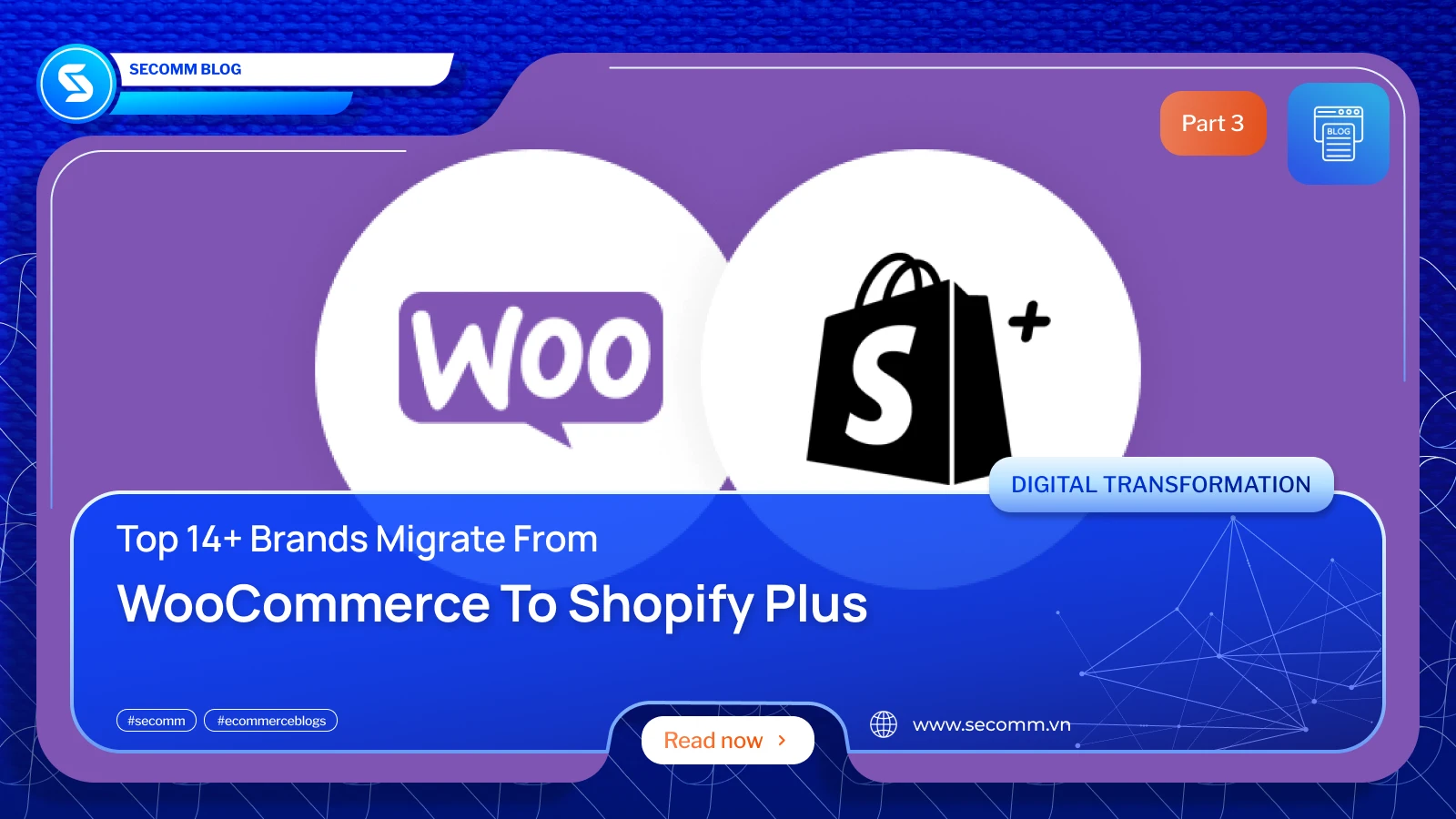
Building upon the narratives in parts 1 and 2, this third part invites you to delve into the stories of the remaining brands within the series of 14 that migrate from WooCommerce to Shopify Plus. Explore how this strategic decision has led to their success in terms of sales and paved the way for sustainable growth in the future.
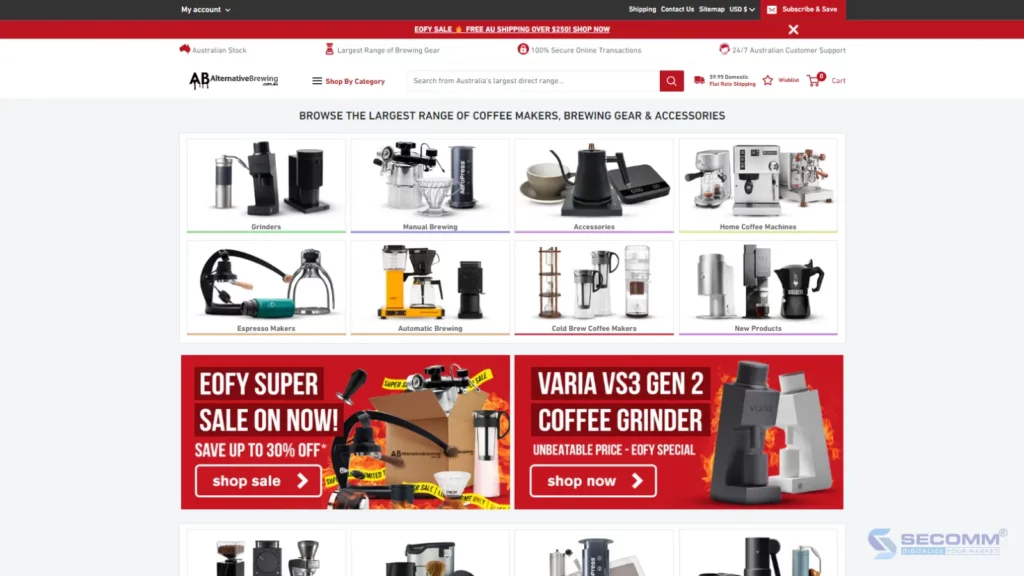
Alternative Brewing is a leading brand in Australia specializing in providing high quality coffee making equipment and utensils. After operating on WooCommerce, Alternative Brewing encountered a problem. WooCommerce eCommerce websites require constant maintenance, causing a lot of worry on shopping occasions like Black Friday or Cyber Monday.
Within 4 months of converting to the Shopify Plus platform, Alternative Brewing’s new eCommerce website loaded faster and had faster checkout, helping the brand significantly increase average order value. Shopify Plus platform with an intuitive, user-friendly interface, Alternative Brewing does not need to deal with a lot of complicated code. This allows the Alternative Brewing team to focus on growing their business and make more informed decisions with Shopify’s in-depth reports and analytics.
Website: https://alternativebrewing.com.au/
Industry: FnB
Traffic: 919,295/month
Rank: #3,071 (Australia) & #144,195 (Global)

Duradry is a leading personal care brand that offers effective antiperspirant products. Operating on WooCommerce costs Duradry a lot of money when testing many different marketing campaigns. The brand migrated to the Shopify Plus platform to take advantage of many exclusive tools and solutions that help them optimize operations and deploy marketing processes more effectively.
Duradry also leverages Shopify Collabs to partner with popular content creators to drive marketing success, bringing Duradry products to more potential customers. The result was 250 content creators joining Duradry’s community, $50k in sales through Shopify Collabs in less than 7 months.
Website: https://duradry.com/?view=hero-a
Industry: Beauty & Cosmetics
Traffic: 386,080/month
Rank: #119,405 (USA) & #445,775 (Global)

AMR Hair & Beauty is one of the leading suppliers of hair care and beauty products in Australia. Established in 2004, AMR has quickly grown to become a trusted destination for hair salons and individual consumers.
Although WooCommerce has served AMR Hair & Beauty well for many years, with the rapid growth of the business, the platform began to show its limitations. Among them are limited scalability, difficult order management, poor security, and suboptimal customer support.
After switching to Shopify Plus, AMR Hair & Beauty leveraged the B2B on Shopify solution to build a wholesale store and further customize advanced search features and filtering options. This means AMR Hair & Beauty’s B2B customers can quickly narrow down search results and view products along with prices and offers. As a result, AMR Hair & Beauty increased sales by 200%, average B2B order value by 77%, and conversion rate by 93%.
Website: https://amr.com.au/
Industry: Beauty & Cosmetics
Traffic: 258,448/month
Rank: #8,360 (Australia) & #381,873 (Global)

Abode Living was founded in 1991 and since then the brand has become Australia’s leading supplier of luxury bed linen, using the highest quality European fabrics and sewing products in its own factories. I’m in Australia.
With the need to increase online sales in Australia and other markets, and upgrade customer experience. However, the previous platform the company used, WooCommerce, did not offer enough flexibility to customize advanced features. WooCommerce also doesn’t give Abode Living the ability to add international marketplaces to its existing eCommerce system. Switching to Shopify Plus met all of Abode Living’s goals. The brand saw a 15% increase in average order value, faster page load speeds, and faster responses.
Website: https://www.abodeliving.com/
Industry: Home Funishing
Traffic: 16,645/month
Rank: #57,874 (Australia) & #2,352,607 (Global)
Final Words
So, SECOMM has gathered insights from 14 representative brands that courageously stepped out of the “WooCommerce world” to revamp their eCommerce websites with Shopify Plus. These brands prioritize customer experience and streamlined processes, inspiring others to confidently opt for platform migration.
Contact SECOMM or call directly at (+84)28 7108 9908 for advice and implementation of the eCommerce migration process from WooCommerce to Shopify Plus today!
 2
2
 3,687
3,687
 0
0
 1
1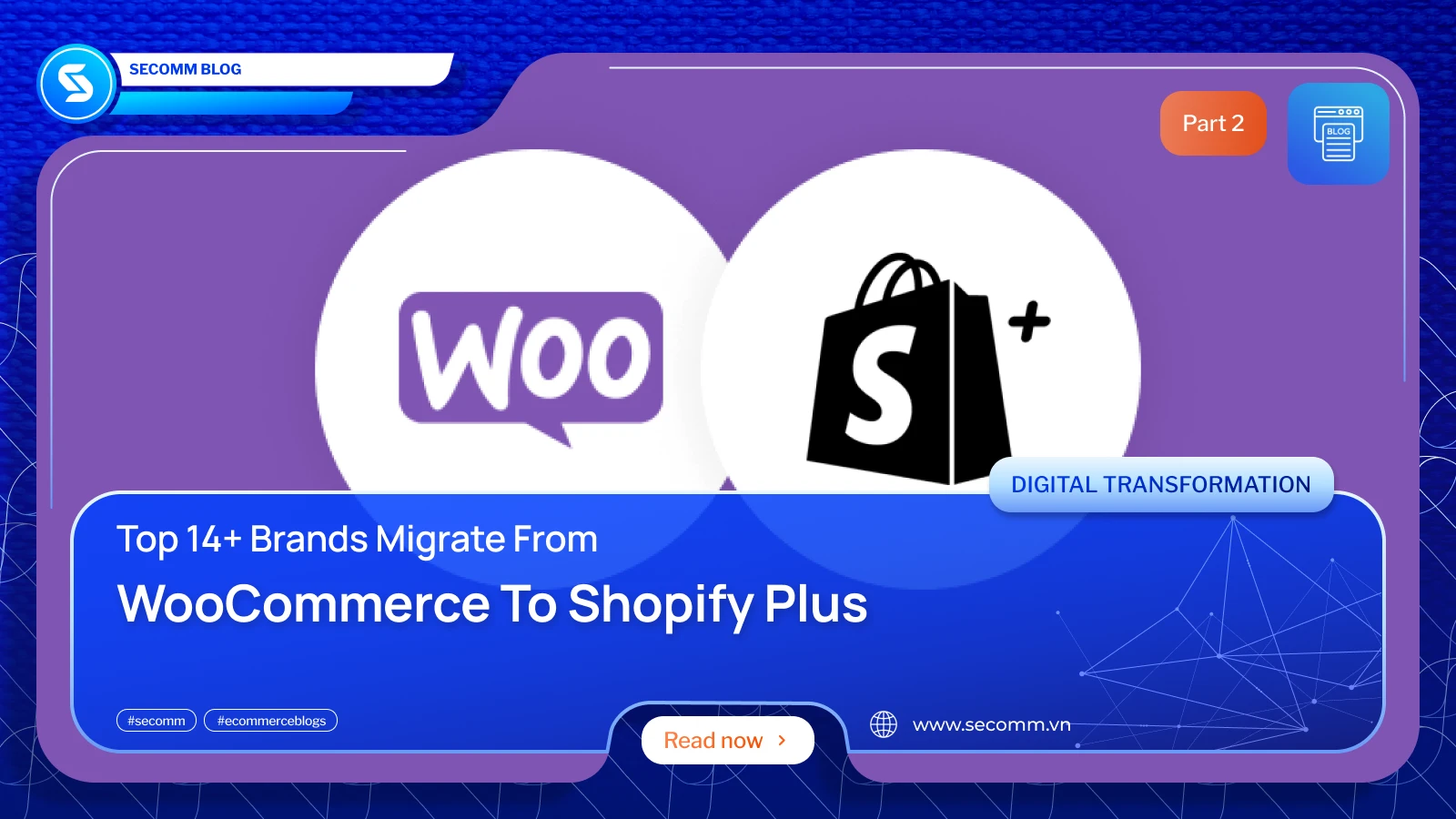
When it comes to brands that re-platformed from WooCommerce to Shopify Plus, it’s good to read their success stories in sales behind.
In the second part of this series, let’s continue to delve into more brands that chose to migrate their eCommerce platforms from WooCommerce to Shopify Plus, and explore how this decision paved the way for boundless success.

HiSmile is a globally renowned brand for teeth whitening products, aiming to help customers achieve a bright, confident smile. Founded in 2014 in Australia, HiSmile quickly gained attention due to its high-quality, easy-to-use, and effective products.
In the early days of its eCommerce operations, HiSmile’s WooCommerce website performed well. However, as HiSmile gained recognition and became more popular, website traffic began to surge, especially during sales events. Page load issues and site crashes cost the HiSmile team a lot of money in repairs and maintenance. Therefore, they decided to seek a more robust and stable solution and chose Shopify Plus.
With the new Shopify Plus website, HiSmile boosted its social media sales strategy and expanded into the global market. To date, HiSmile has attracted over three million social media followers, 5.5 billion social media impressions, and over 1.5 billion views on its social media videos. These numbers demonstrate the brand’s extensive customer reach. Additionally, global sales have significantly increased since the transition.
Website: https://int.hismileteeth.com/
Industry: Beauty & Cosmetics
Traffic: 4.55M/month
Rank: #10,390 (USA) & #33,392 (Global)

Muscle Nation is renowned in the fitness and sports fashion industry, established with the goal of providing high-quality products tailored to the needs of fitness enthusiasts. The Muscle Nation team focuses on delivering an optimal customer experience and implements social media sales strategies. In its first year, the brand earned $1 million in revenue. At that time, Muscle Nation only had a basic website with eCommerce integration, which led to performance issues and a decline in sales.
Since transitioning to the Shopify Plus platform, Muscle Nation has leveraged the superior ecosystem of apps and tools offered by Plus to customize customer experiences and specific features. The brand uses Shopify Flow to manage high-risk orders and tag customers, Launchpad to handle product releases and event launches, and Peoplevox for warehouse management.
As a result, Muscle Nation generated over $4 million in revenue on Black Friday 2019 and handled more than 208,000 customers shopping simultaneously without any website issues.
Website: https://musclenation.org/
Industry: Fashion
Traffic: 961,900/month
Rank: #2,676 (Australia) & #137,488 (Global)

Junglück is a renowned cosmetics brand in Germany, known for its natural and environmentally friendly skincare products. Initially, Junglück used WooCommerce to manage its online store. However, with the brand’s rapid growth, WooCommerce began to show limitations, including slow page load speeds, poor website performance, and restricted integration and scalability.
The cosmetics brand decided to switch to the Shopify Plus platform. This transition allowed Junglück to seamlessly integrate with various third-party systems such as CRM and ERP, enhancing operational efficiency. As a result, Junglück increased its revenue sevenfold since implementing the Shopify Plus website, boosted average order value by 22%, and improved conversion rates by 34%.
Website: https://junglueck.de/
Industry: Beauty & Cosmetics
Traffic: 355,059/month
Rank: #12,653 (Germany) & #308,899 (Global)

LVLY is a prominent brand in the gift and fresh flower arrangement industry, known for its sophistication and modern style. Each LVLY product is meticulously designed and delivered promptly to the recipient, perfectly conveying messages of love and care.
Previously, LVLY used the WordPress platform and WooCommerce plugin to build its eCommerce website. The brand encountered many customization limitations, and the basic features gradually failed to support expansion. Particularly during major shopping events, the system became overloaded and couldn’t handle the high traffic volume. LVLY decided to switch to the Shopify Plus platform. The platform migration took less than 90 days without reducing the conversion rate. The scalability of Shopify Plus helped LVLY achieve its biggest Valentine’s Day sales ever in 2023. Personalization options and add-ons, which LVLY could not implement on its previous platform, also played a crucial role in the cross-sell/up-sell strategy during this shopping event.
Website: https://www.lvly.com.au/
Industry: Gifts & Flowers
Traffic: 354,352/month
Rank: #6,734 (Australia) & #334,427 (Global)

Since its establishment in 1971, Mandaue Foam has become an indispensable name in the furniture industry in the Philippines. After four years of using the standard Shopify version, Mandaue Foam upgraded to Shopify Plus to seek solutions for expansion and customization.
The brand utilized LaunchPad – an exclusive feature of Shopify Plus – to schedule marketing campaigns and automate product price updates and discounts. Because LaunchPad allows tracking the performance of each campaign in real-time, the Mandaue Foam team can understand customer behavior and adjust campaigns accordingly.
Next, with Shopify Flow, Mandaue Foam automated its order management process by creating a workflow where, as soon as an order is placed, one of the 28 physical locations with inventory for that product is notified to process the order. This process ensures order fulfillment speed while eliminating the need for manual order tracking.
The platform switch and the implementation of eCommerce automation have helped Mandaue Foam increase order volume by 200%, total sales by 151% YOY, and customer return rate by 16%.
Website: https://mandauefoam.ph/
Industry: Furniture
Traffic: 486,503/month
Rank: #2,745 (Philippines) & #170,520 (Global)
Final Words
Here are the next 5 brands in the series re-platform from WooCommerce to Shopify Plus. Throughout SECOMM’s process of executing platform conversion projects, whether from WooCommerce or any other eCommerce platform to Shopify Plus, the pivotal factor determining success is a detailed and well-structured conversion plan.
Contact SECOMM or directly call the hotline at (028 7108 9908) to collaborate on devising the optimal plan for the platform migration to Shopify Plus.
 2
2
 3,281
3,281
 0
0
 1
1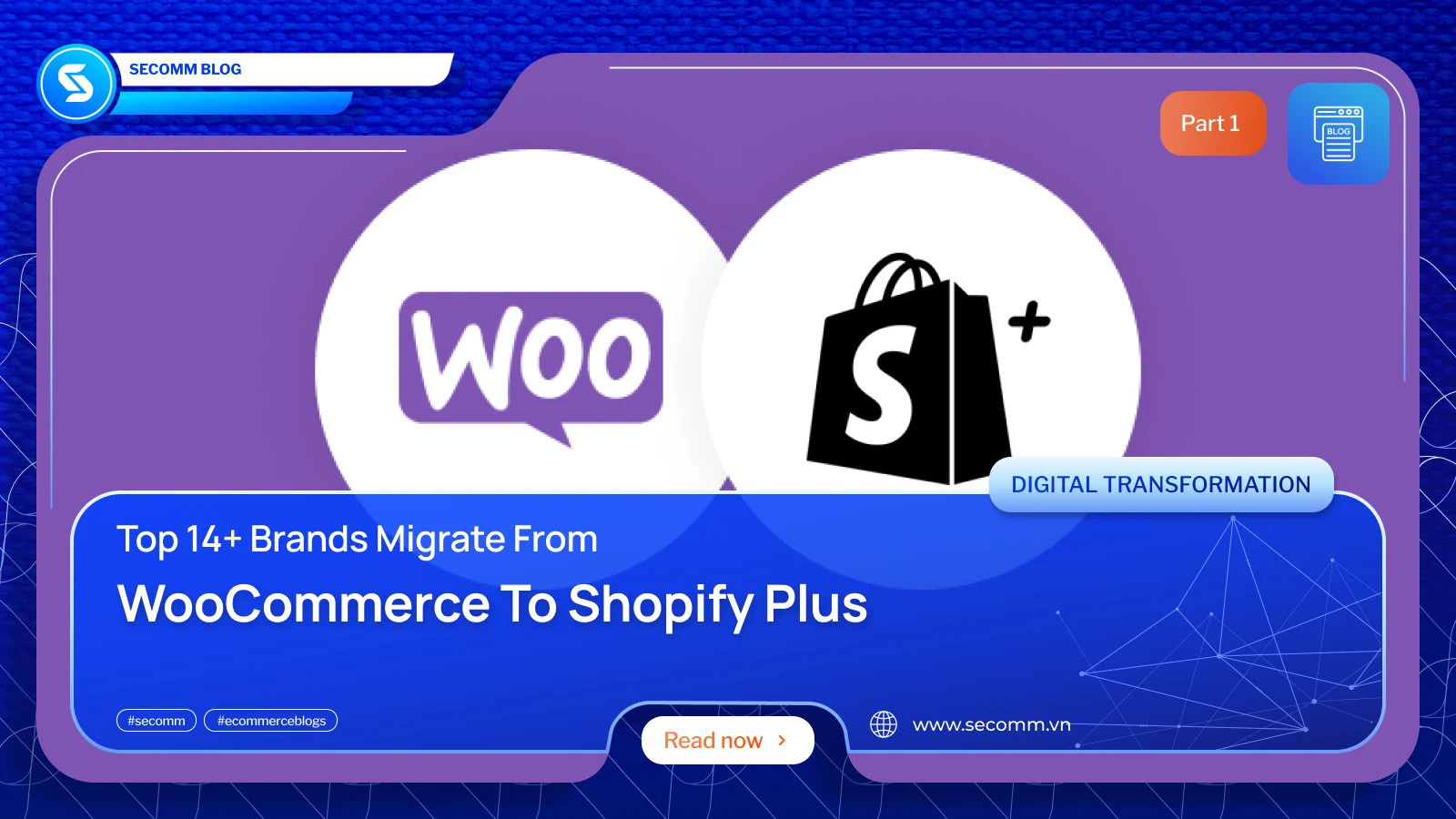
WooCommerce is known as the ‘golden standard’ for many eCommerce businesses. With its intuitive, user-friendly interface and free usage, WooCommerce enables businesses to start operating immediately.
However, its limitations in customization, scalability, and performance, along with the need for ongoing maintenance, have driven many brands to look for better solutions beyond the “WooCommerce world.” Shopify Plus has become a popular choice for those seeking to optimize their platform transition.
Let’s delve into why the five brands below chose to migrate their e-commerce websites from WooCommerce to Shopify Plus and how this decision has boosted their conversion rates and sales.

The Woobles is a prominent brand specializing in crochet kits for beginners, with a mission to bring joy and creativity through learning to crochet. Founded with the goal of making it easy for people to access and experience the art of crochet, The Woobles provides complete kits and detailed instructions, enabling users to create adorable products within just a few hours of learning.
After a period of selling on Etsy, the company decided to build its own eCommerce website. Initially, they chose WooCommerce and took only a few weeks to set up the site. However, as The Woobles’ brand grew more popular and website traffic increased, the page loading speed became inefficient. They realized that the money saved on platform fees was far outweighed by the costs of fixing technical issues and maintaining the system.
Switching from the WooCommerce platform to Shopify Plus allowed The Woobles to optimize their investment and leverage the application ecosystem and solutions offered by Shopify and third parties. Shopify’s robust infrastructure helped The Woobles provide customers with a customized shopping experience and handle surges in traffic. Notably, The Woobles’ Shopify Plus website can maintain an uptime of up to 99.99%.
Website: https://thewoobles.com/
Industry: Toys and Gifts
Traffic: 4.997M/month
Rank: #6,216 (USA) & #31,974 (Global)

Wilding is a prominent shoe brand that specializes in providing comfortable and stylish footwear for consumers. In 2018, Wilding experienced remarkable growth. However, despite a fairly high repeat customer rate, the conversion rate for new customers did not meet expectations.
With a multi-channel sales strategy, Wilding decided to transition from WooCommerce to the Shopify Plus platform to rebuild its eCommerce system. Additionally, the brand opened several showrooms in various locations across Germany and implemented the Shopify POS solution. This allows customers to try on shoes before deciding to purchase either in-store or through the website. The Shopify POS system integrates sales channels and links transactions, enabling Wilding to manage inventory, orders, and track customer behavior more easily and efficiently.
Website: wildling.shoes
Industry: Fashion
Traffic: 1.783M/month
Rank: #4,971 (Germany) & #80,383 (Global)

Since its founding in 2019, Sunology has gradually established itself as one of Europe’s leading solar equipment providers. After a long period of eCommerce implementation with WooCommerce, Sunology decided to switch to Shopify Plus to seek better customization and scalability solutions to achieve its growth and global expansion goals.
Using Shopify Script allows the company to manage custom material allocations for each solar device. This way, customers can design solar power stations tailored to their specific needs. In addition to streamlining and optimizing Sunology’s management processes, Script also optimizes checkout to provide a more appealing shopping experience for customers.
Sunology also leverages the Shopify Markets tool to quickly set up and efficiently manage multiple stores from a single dashboard. This application makes it easy to translate store content from one language to another, significantly supporting Sunology’s international expansion ambitions.
Website: https://sunology.eu/
Industry: Home & Garden
Traffic: 583,349/month
Rank: #12,355 (France) & #353,837 (Global)

T1TAN is a brand specializing in the production and supply of high-quality sports equipment and accessories, particularly in the field of football. T1TAN’s flagship product is goalkeeper gloves, renowned for their durability, comfort, and superior protection. These gloves are developed to meet the most stringent standards.
With their WooCommerce system, T1TAN experienced a website crash during a sale of limited edition products at discounted prices. The T1TAN team realized they needed a more robust and flexible eCommerce platform. Since switching to Shopify Plus, T1TAN has handled multiple major shopping events with surges in traffic and transactions without any website crashes. This platform change has resulted in a 25% increase in conversion rates, zero downtime, and expansion into six additional markets across Europe.
Website: https://uk.t1tan.com/
Industry: Sport
Traffic: 492,054/month
Rank: #621,737 (USA) & #241,413 (Global)

RUDIS is a renowned brand specializing in products and equipment for wrestling, with a mission to support and enhance the performance of athletes at all levels. RUDIS products are designed using advanced technology and premium materials, ensuring durability, comfort, and high performance.
As their eCommerce business grew rapidly, RUDIS struggled to scale their existing WooCommerce system, making a platform switch the only viable solution. RUDIS chose Shopify Plus. After launching the new website, the RUDIS team quickly integrated ERP NetSuite and third-party systems to optimize sales, shipping, and payment processes. With Shopify Plus, RUDIS achieved unprecedented growth, including:
Website: https://www.rudis.com/
Industry: Sport
Traffic: 395,166/month
Rank: #42,519 (USA) & #252,797 (Global)
Final Words
Here are five brands that have witnessed a remarkable change in sales by re-platforming from WooCommerce to Shopify Plus. An important point to note is that while WooCommerce is free and easy to use, complex customizations can be costly and sometimes impractical due to limitations in WordPress and WooCommerce infrastructure. Additionally, businesses may face performance and website speed issues, leading to higher costs for system repairs and maintenance.
On the other hand, Shopify Plus provides businesses with flexible customization options at a more optimal cost, and maintenance and updates are streamlined following Shopify’s standards.
Need more help? Contact SECOMM today!
 18
18
 3,116
3,116
 0
0
 8
8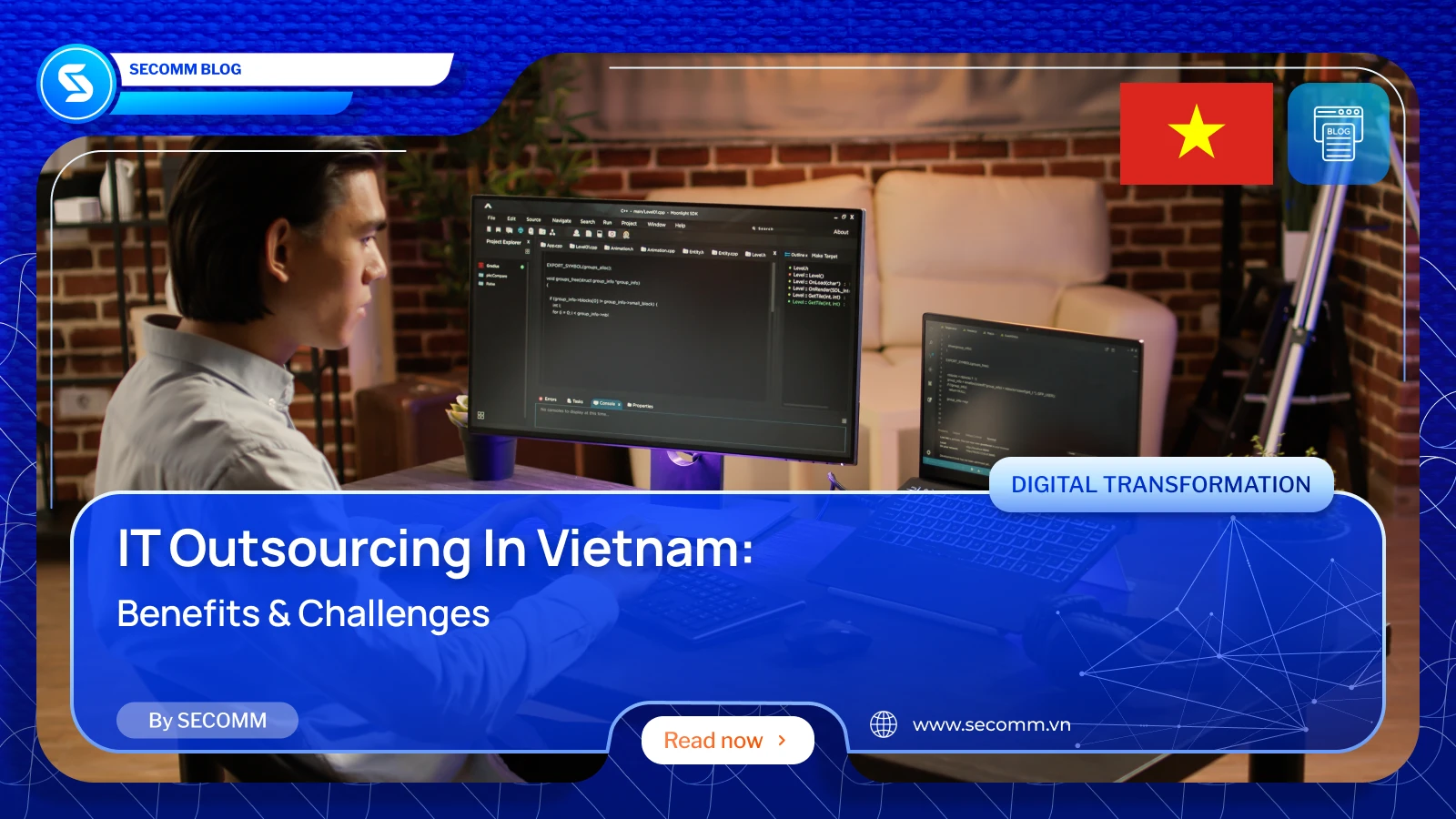
IT outsourcing has become a prevalent strategy in today’s business landscape, offering several advantages such as cost savings, access to specialized expertise, and operational agility. For years, Vietnam has stood out as a prime destination for IT outsourcing due to its favorable business ecosystem, competitive labor costs, and government support.
In this blog post, SECOMM explores why Vietnam is an ideal choice for businesses seeking to outsource their IT requirements. We’ll delve into the country’s strengths and potential drawbacks, providing valuable insights for decision-makers.
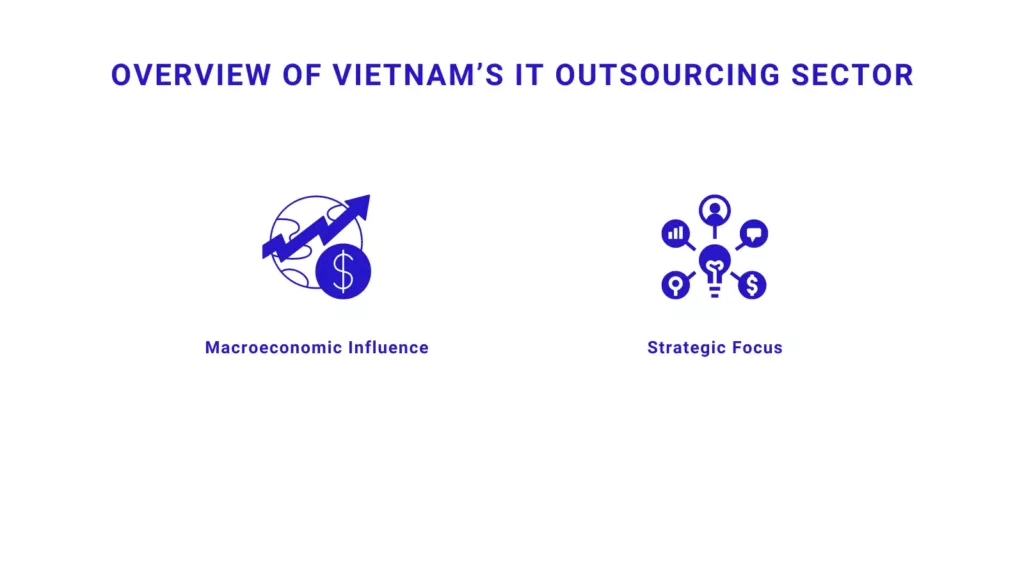
Vietnam’s dedication to advancing science and technology has led to a flourishing ICT market, valued at $7.7 billion in 2021, with ongoing growth fueled by digital adoption in both the public and private sectors.
Macroeconomic Influence: Vietnam has emerged as one of the fastest-growing economies globally, buoyed by a stable political environment and government support for the IT industry. Furthermore, rising investments in cutting-edge technology and startup funding fuel the market’s expansion.
Strategic Focus: According to the International Trade Administration, the Vietnamese government recognizes Information and Communication Technology (ICT) as a pivotal industry and a driver of socio-economic progress. Additionally, Vietnam’s commitment to core tech advancements is evident through significant investments in AI and cloud computing by the government and major companies.
Due to the above elements, the IT outsourcing industry in Vietnam is growing rapidly with an impressive annual growth rate of 16.38% from 2024 to 2028, resulting in a substantial market volume of US$1,282.00 million by 2028.
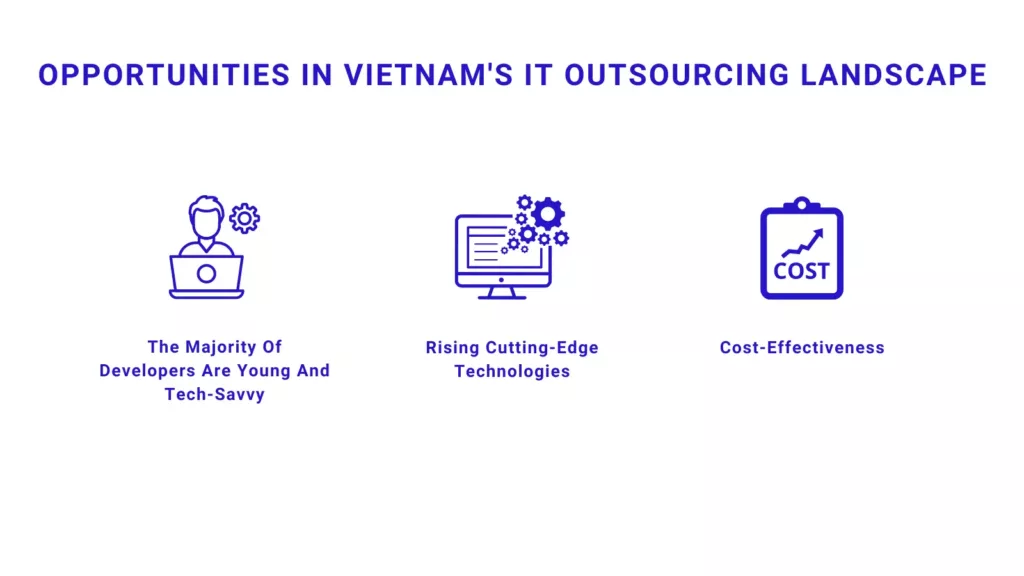
Around 56% of developers fall within the 20 – 29 years age group, this number is expected to form about one-third of Vietnam’s workforce by 2025.
There are approximately 50,000 to 57,000 students who graduate in university IT programs annually. Due to this, Vietnam was ranked among the top 10 globally for IT graduates and the top 6 for quality software services. TopDev’s 2023 report highlights that Vietnam’s robust community of around 530,000 tech professionals is well-suited to meet the varied demands of international businesses.
Moreover, the Ministry of Education and Training manages IT education in Vietnam. Recent changes have allowed more flexibility in higher education institutions to encourage innovation. For instance, separate entrance exams for each institution have been eliminated, resulting in improved admission rates.
Cloud computing in Vietnam has grown at a 30% CAGR recently, driven by robust IT infrastructure and data centers. This progress aligns with Vietnam’s digital transformation agenda. Moreover, with the aim of data security, many Vietnamese companies prefer “make in Vietnam” cloud computing services to foreign ones.
Vietnam has also made strides in artificial intelligence readiness, moving from 55th to 39th globally. It ranks 9th in East Asia and 5th in ASEAN, with an AI readiness score of 54.48.
In 2023, the average monthly salary for developers with fresher-level salaries at $514 and for director-level salaries at $2,680. Overall, the annual salary of a Vietnamese IT developer is $7,173, which is incredibly low, it only amounts to nearly 25% of Chinese wages ($29.840) and around 35% of Indian wages ($20.464). These cost benefits, coupled with a commitment to high-quality workflows, are making Vietnam an increasingly popular choice for international organizations seeking dependable and affordable IT services.
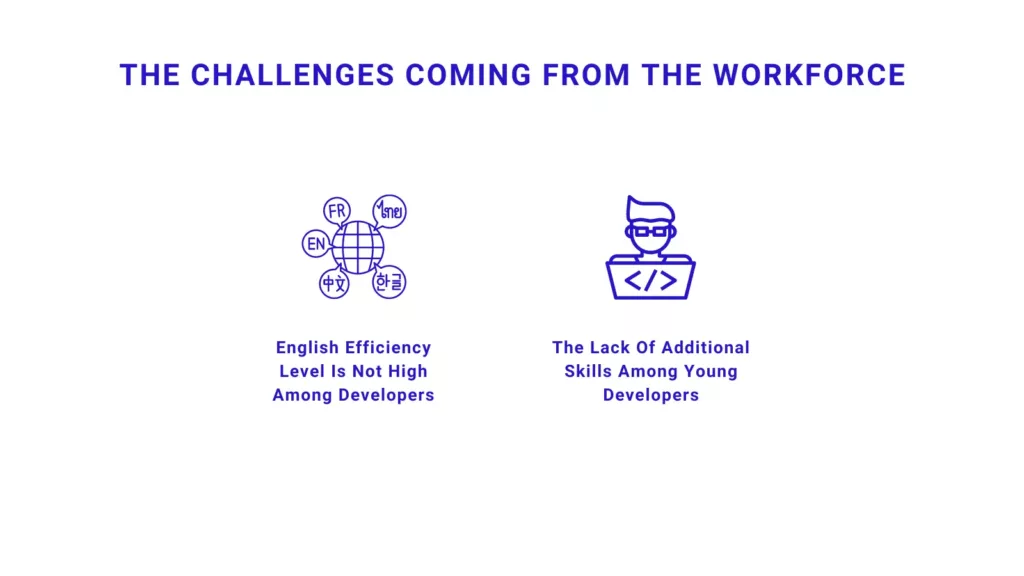
The IT sector’s language requirements are becoming stricter, with over 9% of foreign companies seeking IT staff with professional English skills. The demand for English proficiency has shifted from a nice-to-have to a must-have. Although Vietnamese tech professionals have strong technical abilities and can communicate effectively, their English-speaking skills may not be as advanced as those in other ASEAN countries.
In 2022, only 5% of Vietnam’s workforce was fluent in English, which is less than the fluency rates in Indonesia (10%), Malaysia (21%), and Thailand (27%). This has caused a challenge in the recruitment process for IT outsourcing that many skilled developers are getting denied due to their English level.
Additionally, the new generation of developers, mainly Gen Z, is experiencing a growing skills gap because of the fast-paced technological changes. Yet, an impressive 72% of them are keen to learn digital skills, which is higher than the global average of 52%. This enthusiasm is a positive sign for the future, showing they understand the challenges and are ready to tackle them.
Upon engaging with SECOMM, you will gain access to a dedicated IT team that meets standards in English proficiency and technical competency. Book your FREE consultation with SECOMM’s experts today.
Explore SECOMM’s project: Assembling a Specialized Vietnamese IT Team for LandNow’s Website Development.
3. To Sum Up!
Vietnam’s IT outsourcing market has seen consistent growth, thanks to significant investments from both the government and foreign companies. If you’re seeking an IT team provider in Vietnam, consider SECOMM. Their exceptional talent can drive innovation and elevate your business objectives. Reach out to SECOMM at (+84) 28 7108 9908 to explore a partnership.
 4
4
 3,523
3,523
 0
0
 5
5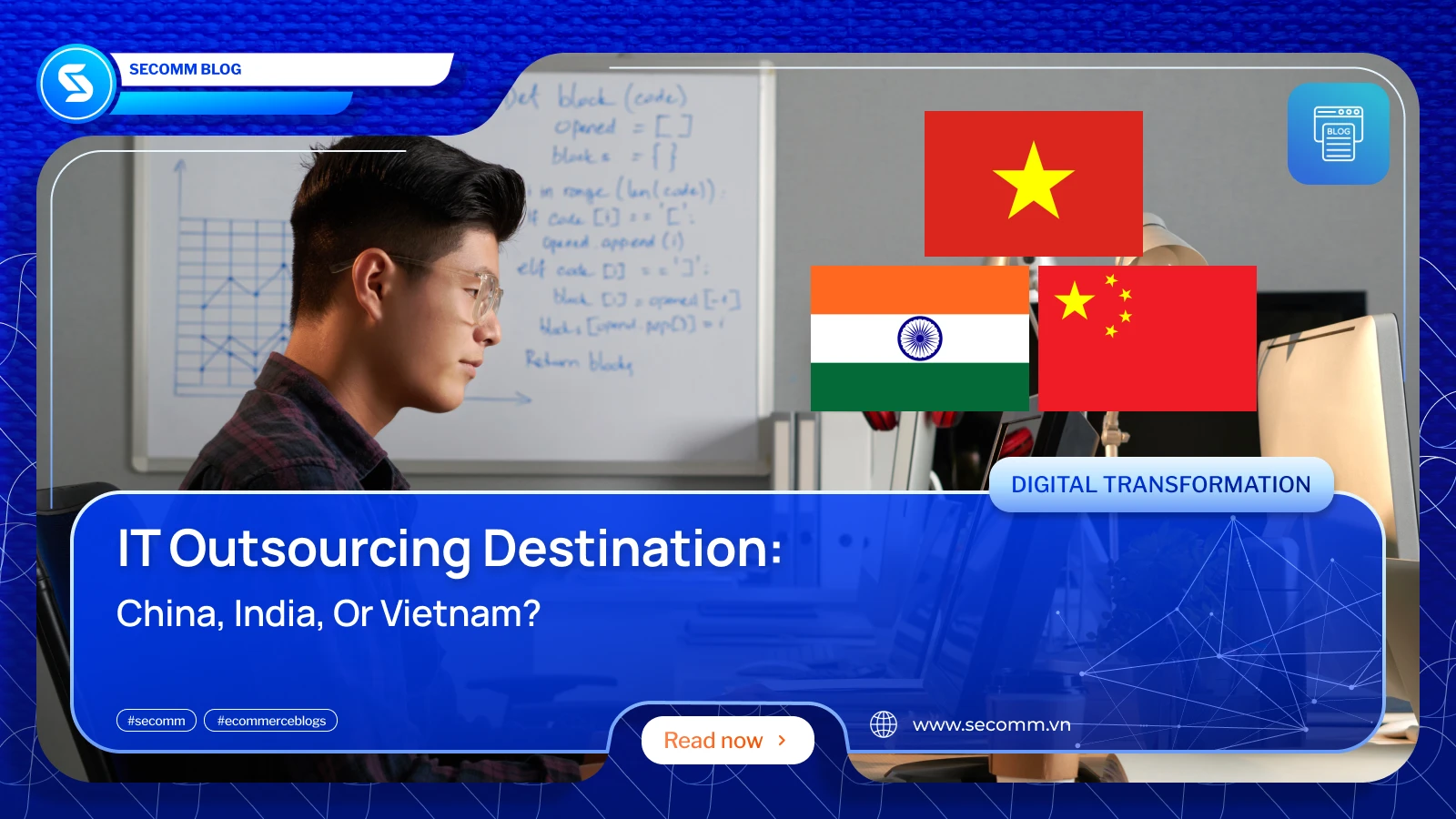
The IT Outsourcing market worldwide is projected to grow annually by 10.99%, reaching a market value of US$777.70 billion by 2028.
While India and China have long been the go-to nations for IT dedicated teams, new players like Vietnam are gaining ground. Companies have various choices based on language, cost, culture, and government support.
In this blog, SECOMM will explore the advantages and disadvantages of outsourcing IT functions to India, China, or Vietnam. This analysis will help companies make informed decisions about which country aligns best with their resources and strategic objectives.
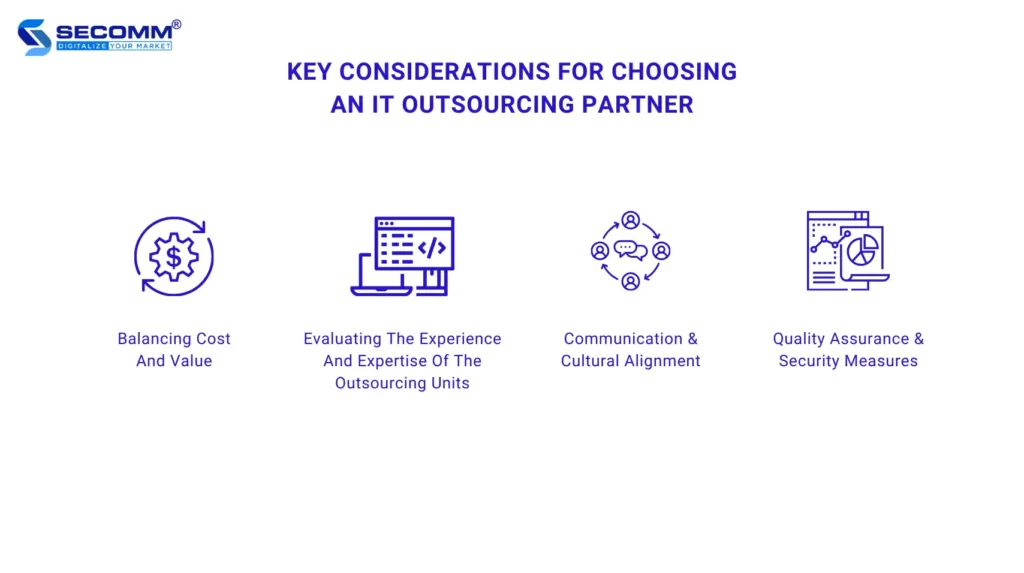
Before going further into the main points of the three countries, there are some key points that companies should be aware of when choosing an IT outsourcing partner.
Selecting a partner who can provide both quality and competitive pricing is vital for the company’s campaign success. When assessing cost benefits, look beyond immediate savings. Consider the long-term expenses of communication, travel, staff turnover, and management tasks. These factors can impact your financial outcomes over time. For example, a company outsourcing to a country with low English proficiency may lead to communication challenges. To address this, the company might need to employ a local translator to ensure smooth operations.
A Deloitte study reveals that 59% of companies outsource software development for specialized skills and expertise. It’s important to choose partners known for providing skilled IT professionals and delivering projects akin to yours. Experience in similar projects or industries is a plus, as partners with relevant domain knowledge can offer valuable insights and tailored solutions. For example, in Vietnam, SECOMM is one of many companies proud of its ability to handle big projects globally easily due to its past experiences of working with many big names in the eCommerce industry.
Cultural alignment and good communication are important but often ignored in outsourcing partnerships. Your partner should have values, work ethics, and communication methods similar to your company’s. Communication should be transparent and frequent throughout the project. Choosing a partner with staff who speak a language that both parties understand is important to avoid language barriers that could slow down progress.
Quality control is vital for software that’s free of bugs. Your outsourcing partner should follow the best practices in data security and software development. Quality assurance tests should be part of the development process to catch and fix issues early. Security is equally important for outsourced DevOps services. Check their security measures, data protection policies, and compliance with industry standards. They must protect sensitive data according to industry regulations and have clear methods for protecting intellectual property and confidential information.
Outsourcing to China is a strategic choice for many Western companies, largely due to the cost-effective services and access to a highly skilled workforce. China’s e-commerce market is the largest globally, and the country offers a stable economic environment, low corporate taxes, and numerous top-tier seaports. Moreover, China boasts one of the world’s largest and most proficient tech talent pools, adding to its appeal as an outsourcing hub.

Outsourcing IT to China offers clear financial benefits. Chinese developers provide services at competitive rates, which can lead to significant cost savings for businesses. This affordability doesn’t come at the expense of talent, as China has a large pool of skilled developers. The salaries for these developers are generally lower than in the US where Chinese professionals often charge around $50 to $100 an hour, with an average of around $29,840 a year.
Moreover, China is a leading tech hub with one of the largest and most skilled IT dedicated teams in the world. By 2024, the global number of developers is expected to reach 28.7 million, with China contributing significantly to this growth. The country’s developer population is growing at a rate of 6% to 8%. China also prioritizes high-quality education, with 24 of its universities ranked among the top 200 worldwide. The Chinese government is actively launching educational initiatives to enhance technical skills, preparing its citizens for the evolving digital world.
The government invests in projects and infrastructure to aid these companies and streamline outsourcing. In 2020, China announced a massive $1.4 trillion investment to enhance public digital infrastructure. This investment is a boon for companies considering China for digital outsourcing, as it simplifies the integration of local talent.
Additionally, there are still some issues that companies need to be aware of when contacting the IT dedicated team in China. Firstly, language barriers are significant when outsourcing to China, as not all IT professionals are proficient in English, potentially causing miscommunications and project delays. Cultural variances can also affect how communication is perceived and managed.
Additionally, on the topic of intellectual property, China’s laws may vary from those in other nations, posing a risk to the security of your ideas. Moreover, stringent data privacy and security regulations by the Chinese government can pose operational challenges for foreign IT service providers.
India has consistently been a dominant force in the global IT outsourcing sector, attributed to its extensive talent pool of IT experts and a favorable business ecosystem. The industry is projected to witness a compound annual growth rate (CAGR) of 17.58% between 2024 and 2028, culminating in a projected market value of USD 20.09 billion by 2028.
Clients within India’s IT outsourcing market demand cost-effective, high-caliber services. They seek partnerships with firms that offer comprehensive services, including software development, maintenance, and support, and value providers with industry-specific experience who can deliver solutions tailored to their precise needs. Additionally, India is ideal for businesses seeking experienced developers with strong communication skills for complex projects.

Local outsourcing providers efficiently manage the entire process, including procurement, installation, and testing, ensuring a cost-effective and seamless experience. For example, establishing a website or developing a mobile application can be expensive, but outsourcing to India can reduce these costs by nearly 50%.
Furthermore, India’s lower living costs result in more affordable labor compared to countries like the United States. To illustrate, the average yearly salary for an IT employee based on Glassdoor in India is around $20,464, starkly contrasting the U.S. average of $109,829.
The country’s diverse population contributes to a workforce that includes programmers, scientists, financial experts, MBAs, journalists, and virtual assistants with exceptional skills.
India’s government-funded higher education system is the third-largest globally, after the US and China. According to Statistica, India has over 6.5 million graduates each year, significantly more than the Philippines, which is a major competitor in the BPO and outsourcing sector.
While Indians are proficient in English, the accent may sometimes lead to misunderstandings in verbal communication. It’s advisable to conduct most communication in writing, through emails and chats, to reduce miscommunication risks and maintain a written record for reference if needed.
In software development and IT, the risk of intellectual property (IP) being copied is significant. Without proper safeguards, there’s no guarantee of protection, as projects might be resold.
To protect your interests, it’s wise to sign an NDA with your outsourcing partner. Be careful with IP issues and consider getting legal advice for big projects with substantial financial stakes.
Vietnam has gained prominence in the IT outsourcing industry over the last ten years. It’s now a significant force globally, with a focus on software development, digital content, and BPO. The growth of Vietnam’s IT outsourcing sector is attributed to its youthful, talented workforce, competitive labor costs, and supportive government policies. Plus, its strategic position in Southeast Asia adds to its appeal as an outsourcing hub for regional and international businesses.

Outsourcing to Vietnam offers a key benefit: access to skilled tech talent at affordable rates. Vietnam, located in one of the world’s most cost-effective regions, has leveraged this to become the 6th top destination for software development. In 2022, Vietnam was rated 99.6/100 for low manufacturing costs by US NEWS and is among the lowest in Asia.
This results in significantly reduced IT outsourcing costs compared to other countries. For instance, the average annual income for a developer in Vietnam is approximately $7, 173, which is the lowest among the three. This represents a cost reduction of up to 94% compared to the US, 65% compared to India, and 76% compared to China.
Vietnam’s pool of highly educated and tech-savvy young professionals, many of whom have studied or worked abroad, makes it an attractive destination for outsourcing. Additionally, Vietnam offers technical training in various programming languages through its universities and technical schools, producing around 400,000 IT engineering graduates and 50,000 IT students annually.
Overall, Vietnam is well-equipped to meet the skilled workforce demands of employers seeking outsourcing opportunities, with a lower turnover rate compared to other countries in the field. Companies in Vietnam experience an IT-related turnover rate of less than 5%, making it an appealing choice for businesses.
Major multinational companies and tech giants, including Intel and Microsoft, have established a strong presence in Vietnam by outsourcing software development and IT support services. Additionally, other firms like IBM, Cisco, and Bayer are also expanding their IT roles in Vietnam.
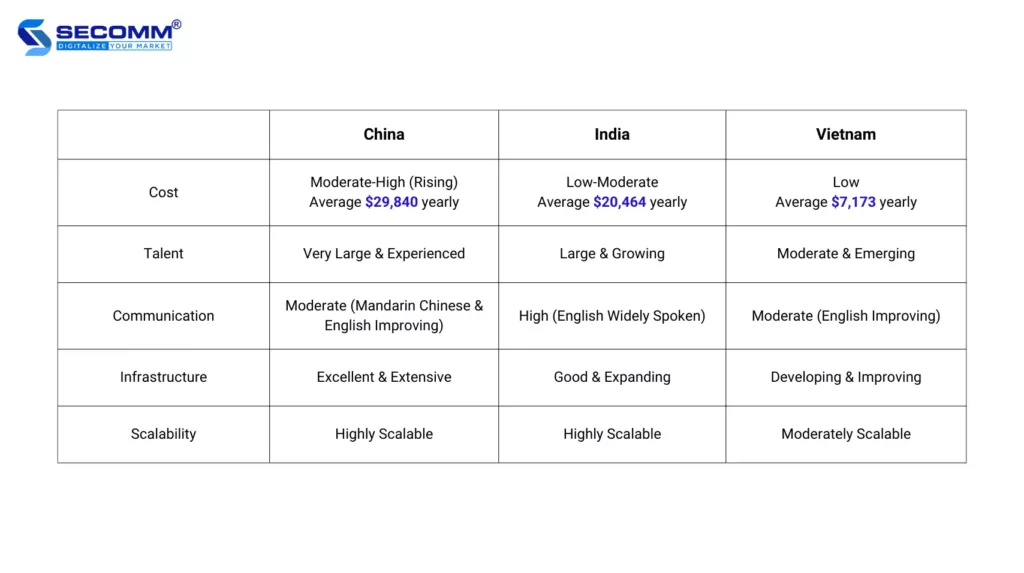
The involvement of these esteemed organizations serves as a testament to Vietnam’s adeptness in managing substantial outsourced or offshore software development initiatives, despite its status as a relatively small emerging nation in contrast to larger, more developed counterparts such as India and China.
Overall, China’s large, albeit aging, labor force and developed infrastructure are offset by rising costs and regulatory concerns. While India shines with its vast, young talent pool, cost-effectiveness, and robust infrastructure, making it a strong contender for scalability and quality. Finally, Vietnam emerges as a compelling choice with its youthful, tech-savvy workforce, competitive costs, and rapidly improving infrastructure.
Read more: IT Outsourcing in Vietnam: Benefits and Challenges
SECOMM stands out with over a decade of experience for organizations seeking a reliable IT-dedicated team in Vietnam. Engaging with SECOMM means your IT projects are in the hands of exceptional talent, driving innovation and advancing your business objectives. To explore a partnership with SECOMM, reach out or dial the hotline at (+84) 28 7108 9908 for a collaboration that can elevate your IT capabilities.
 10
10
 2,991
2,991
 0
0
 1
1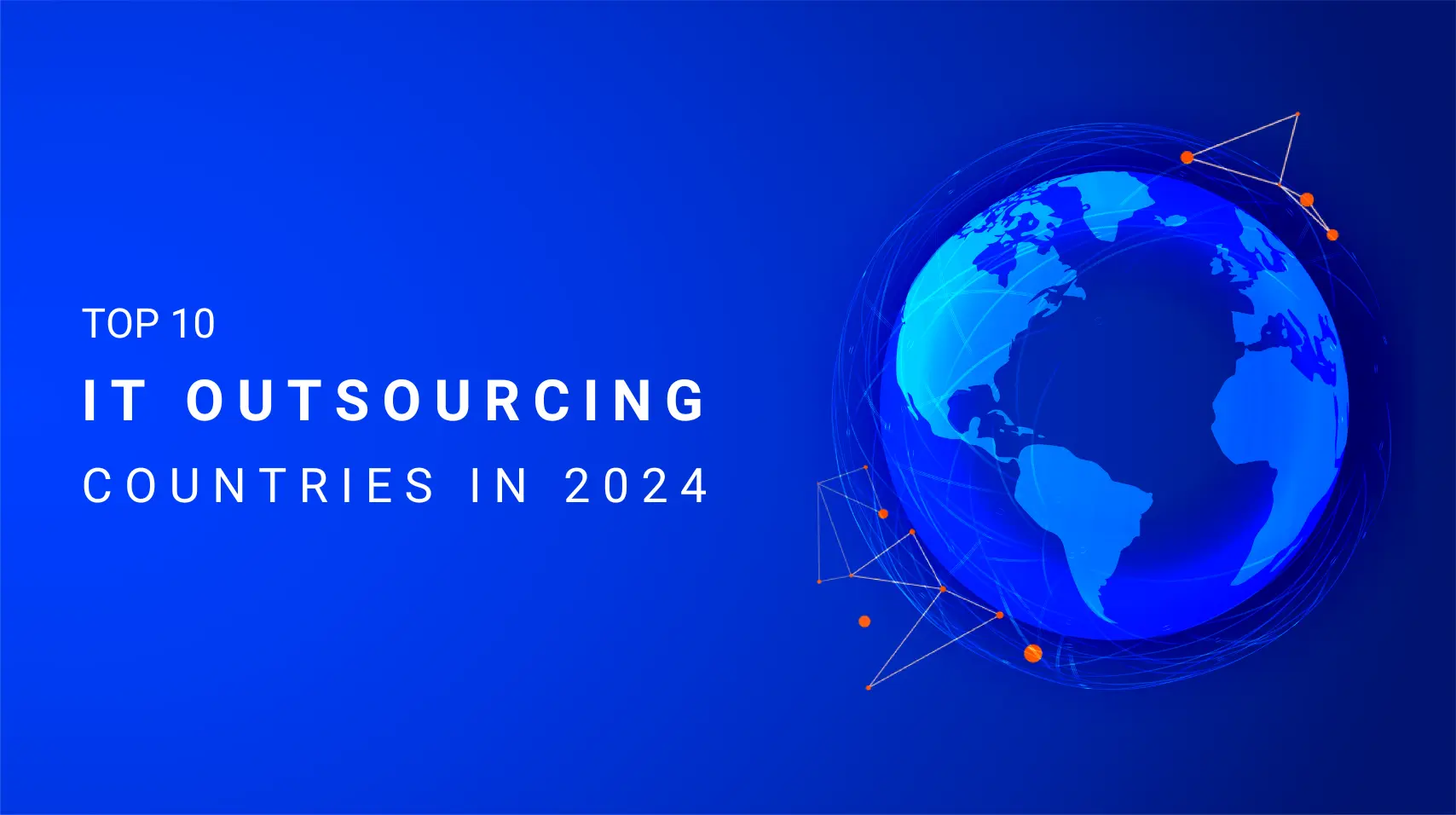
With the economic challenges post-COVID-19, IT outsourcing has become a go-to solution for businesses aiming to use their budgets effectively. They’re partnering with outsourcing companies for IT tasks instead of solely depending on in-house teams.
Meanwhile, the IT sector is rapidly growing, fueled by ongoing tech advancements. Outsourcing is crucial to this growth, which is expected to soar to USD 525.2 billion by 2030, growing at a CAGR of 9.4% from 2023 to 2030. This points to a sustained high demand for IT outsourcing well into the decade.
When considering outsourcing software tasks, it’s crucial to identify the best countries for the job. The ideal locations are those that excel in technological expertise, offer favorable business environments, lead in innovation, and have strong English language proficiency. The following list will highlight the top 10 countries with stand-out IT dedicated teams that could be considered prime choices for IT outsourcing services.

India has consistently been at the forefront of the outsourcing sector and is renowned for its extensive pool of IT and software development talent. The country’s cost-effective services, proficiency in English, and solid tech infrastructure have established it as a preferred choice for global businesses. With more than 1.5 million IT graduates each year, India ensures a continuous influx of skilled professionals to satisfy the increasing demands of the outsourcing market in Asia.
Moreover, India’s cost structure is generally more affordable than Western countries, making it an attractive option for companies looking to outsource development tasks. For instance, according to Upwork, software developers in India typically charge between $18 and $39 per hour, which is significantly lower than the $50 to $60 per hour rate in the United States or Germany, with the average rate from $150 to $250 per hour. This combination of a large, skilled workforce and competitive pricing positions India favorably against other leading IT outsourcing destinations.

Just like India, China’s massive talent pool and diverse skill set make it one of the best countries for outsourcing, and it has emerged as an IT outsourcing power dominating the labor market. With an education system that promotes Math and Science, China provides some of the world’s best technology and IT services.
In terms of talent pool, China is one of the largest producers of IT graduates worldwide, boasting over 3 million IT graduates a year (this number is quite significant compared to India due to its large population). This vast number of highly educated and skilled individuals further solidifies China’s position as a desirable destination for outsourcing.
Additionally, the Chinese government actively supports IT development and invests in education to build a strong talent base. It focuses on advancing STEM (science, technology, engineering, and mathematics) education, which is essential for the IT sector. This approach improves learning in science and math, which is foundational for IT expertise.
In 2024, China remains a competitive choice for outsourcing, with an average IT outsourcing salary of about $20-$45 an hour, striking a balance between cost-effectiveness and quality output. This affordable rate and the country’s commitment to technological advancement make China an appealing choice for businesses worldwide.

The Philippines is a sought-after hub for software development outsourcing and BPO is favored for its cost-effective labor and proficient workforce. English is the official language, simplifying communication and aligning with the country’s strong cultural connections to the US. This understanding of Western work culture is a significant advantage, especially since 94% of the population speaks English.
With around 190,000 developers stationed in key BPO centres like Manila, Cebu, Davao, and Bacolod, the Philippines is recognized as a leading IT outsourcing hub, especially in the healthcare and fintech sectors.
The educational system in the Philippines annually produces approximately 200,000 IT graduates, emphasizing IT and technical skills to create an adaptable and globally competitive workforce. In 2024, the average IT outsourcing salary stood at around $20-$60 an hour, affirming the Philippines’ position as one of the most economical offshore outsourcing destinations.

Similar to the Philippines, Brazil shares cultural affinities with the US, which translates into high-quality IT services at competitive rates. This cultural resonance, coupled with its strategic location, makes Brazil a preferred partner for North American IT firms.
Brazil’s commitment to building a skilled tech workforce is reflected in the production of about 150,000 IT graduates each year. The government’s efforts to perfect the technological education infrastructure set Brazil apart as a top destination for offshore software development.
Although Brazil’s outsourcing costs are slightly high, with the average IT outsourcing salary at approximately $20-$50 an hour and an annual software engineer salary of around $12,000, it remains a competitive market. The country’s youthful population, 38% of which are young, positions Brazil as an ideal locale for hiring junior developers, underlining its robust and skilled tech workforce.

Vietnam is advancing as a notable destination for IT outsourcing, backed by a vast pool of skilled IT professionals. The country’s educational system, with over 300 IT-focused universities and centres, produces around 57,000 IT graduates each year. The Vietnamese government’s dedication to the IT sector is evident through supportive policies and incentives, contributing to Vietnam’s ranking within the top 50 digital nations.
The IT outsourcing market in Vietnam is forecasted to reach $698.90 million in revenue in 2024, with an anticipated annual growth rate of 16.38%, leading to a market volume of $1,282.00 million by 2028. The enterprise software segment is expected to achieve a market size of $247.3 million by the end of 2024. Moreover, the average spend per IT outsourcing employee is projected to be $11.80 an hour in 2024. These figures highlight a dynamic IT outsourcing market with an outstanding IT dedicated team in Vietnam, with growing employment and increasing value per employee, reflecting the nation’s investment in education and technological infrastructure.

Poland is a standout choice for IT outsourcing within Europe. Its central position in Europe and EU membership and a strong pool of software engineering talent make it an attractive base for businesses looking to grow in the European market.
The country’s IT industry is well-developed and supported by numerous universities that provide computer science education. Recent reports indicate that there are between 63,000 and 78,000 students enrolled in IT and ICT degree programs, with an annual graduation rate of about 10,500 to 13,500.
A significant draw for the IT Outsourcing market in Poland is the cost-effective yet highly skilled workforce, which is more affordable than in many other European nations. The cost for offshore software development services in Poland typically ranges from $40 to $56 per hour, depending on the project. This positions Poland as one of the leading Eastern European countries for cost-efficient programming expertise.

Malaysia is gaining traction in the IT outsourcing industry due to its cost-effective solutions and skilled workforce. Over 60% of Malaysians speak English, which, along with strong government support, makes the country an appealing outsourcing destination.
Annually, Malaysia produces around 100,000 IT graduates, reflecting its commitment to digital skills development. The government bolsters this with initiatives like tax incentives and funding for R&D.
In Malaysia’s tech sector, the average monthly salary is about $3,500, with an hourly rate of $14. These rates are lower than in the US or Western Europe. Moreover, a key development in Malaysia’s IT outsourcing is the growth of cloud computing and mobile app development. IT firms are investing in these technologies to offer better and more cost-effective services.

Argentina’s IT industry is attractive to US and European clients due to English proficiency, cultural similarities, and time zone alignment. Competitive pricing and a highly skilled workforce add to its appeal. Web developers’ costs vary from $20 to $60 per hour, or around $14,100 yearly, based on experience.
With over 115,000 developers, many from top universities, Argentina’s education quality is evident. The country’s 2023 QS World University Rankings featured over 40 renowned computer science programs, 14 of which are in Buenos Aires, ensuring well-educated IT professionals.

Egypt’s rise in the IT outsourcing market is attributed to its skilled workforce and cost-competitive services. The country’s low labor costs, combined with a large pool of engineering and development talent, make it a lucrative option for companies seeking IT outsourcing services.
The average hourly rate for IT outsourcing in Egypt in 2024 was between $25 and $50, presenting a budget-friendly choice for businesses. The ITIDA reports that an IT professional’s average annual salary in Egypt is about $10,000, significantly below the global average of $45,000.
Egypt’s educational system contributes around 50,000 IT graduates each year to the industry, ensuring a steady supply of technically skilled professionals. The Egyptian government is proactively enhancing the IT sector by offering incentives and training to expand the talent pool. This initiative is expected to grow the industry significantly.

Mexico’s IT Outsourcing market is attractive for several reasons, including cost savings, access to a pool of skilled talent, and the ability to quickly scale operations.
In 2024, the average hourly rate for IT outsourcing in Mexico was estimated to be between $20 and $40. While this rate is slightly higher than some other outsourcing destinations, it is balanced by the advantages of geographical closeness, time zone compatibility with the US, and a deep understanding of Western business practices.
Mexico’s higher education system is on par with that of the United States and Europe, contributing to the supply of skilled IT professionals, with approximately 120,000 IT graduates produced annually.
The Mexican IT Outsourcing industry has seen steady growth over the past decade and is currently ranked as the fourth-largest IT outsourcing destination in Latin America. The industry’s expansion is expected to continue, driven by increasing demand for services such as software development, data analytics, and cloud computing.
To Sum Up!
The IT outsourcing market in 2024 is a strategic asset for businesses aiming to innovate and grow. It offers cost-effective access to skilled talent, driving operational efficiency and competitive advantage. Outsourcing is no longer just an option; it’s a strategic necessity that allows companies to focus on core competencies while outsourcing non-core activities to experts worldwide.
At Secomm, we can provide you with the best of our IT dedicated team, who have more than 10 years of experience in the IT sector. Feel free to contact SECOMM or call our hotline at (+84) 28 7108 9908 to ensure that your IT operations are handled by top-tier talent, fostering innovation and propelling your business forward.
 2
2
 3,938
3,938
 0
0
 2
2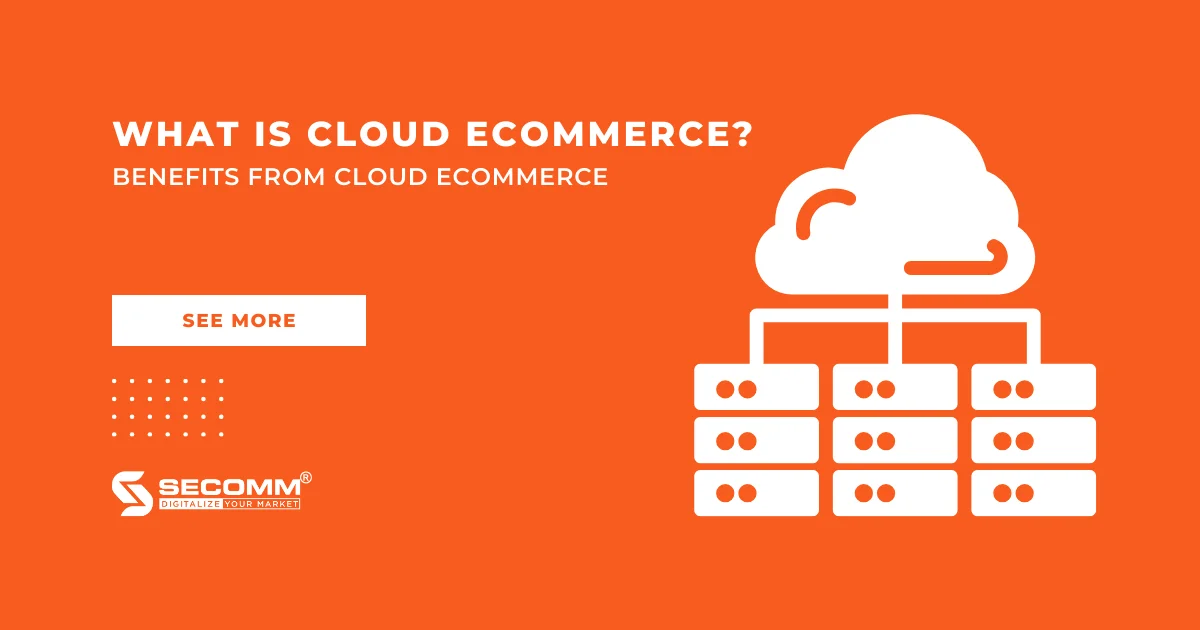
eCommerce has been booming more than ever, driving the demand for new technologies to adapt to the continuous growth of the market. Some emerging eCommerce technologies include VR/AR, MSI (Multi-Source Inventory), PWA (Progressive Web Apps), Headless Commerce, etc. However, among these, the technology that developers and businesses are currently paying the most attention to is Cloud eCommerce.
Cloud eCommerce utilizes server clusters and cloud computing systems from cloud service providers to process large transaction volumes and online sales channel traffic. In simpler terms, Cloud eCommerce involves renting Internet servers based on cloud platforms to process, store, or use applications for various eCommerce business purposes.
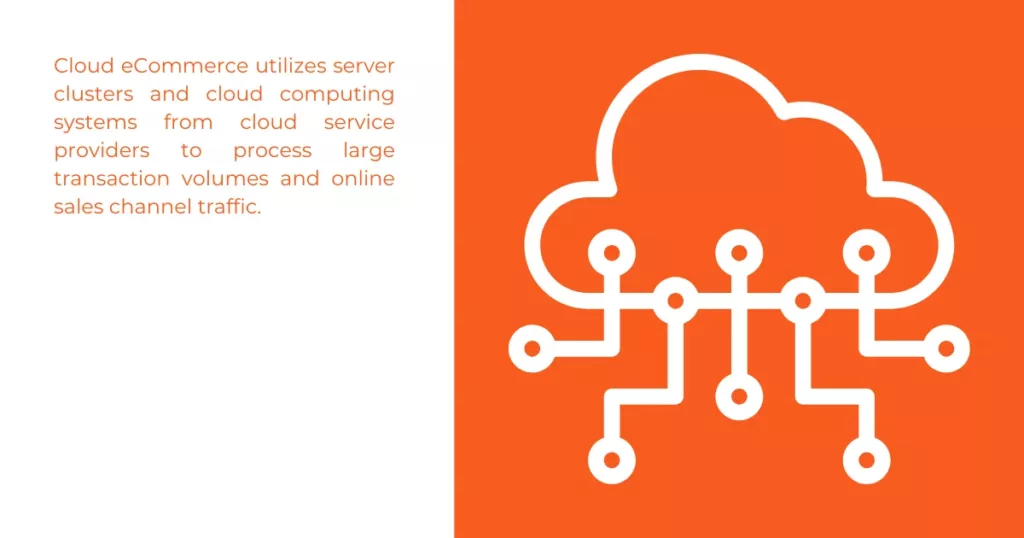
Before cloud-based eCommerce platforms and other solutions emerged, traditional eCommerce platforms like IBM WebSphere and Oracle ATG required on-premise server setups and continuous maintenance. Unlike those “on-premise” eCommerce solutions, cloud-based eCommerce allows companies to outsource their IT infrastructure without the need to invest in equipment and continuous maintenance as before.
This solution helps businesses adapt to the increasing demands of customers, enhance security, simplify maintenance, and integrate new eCommerce applications as needed. For these reasons, Cloud eCommerce is often combined with eCommerce platforms such as Shopify Plus, Salesforce, Magento, etc.
There are several cloud eCommerce solutions to choose from, including IaaS, PaaS, and SaaS, each with different resource requirements.
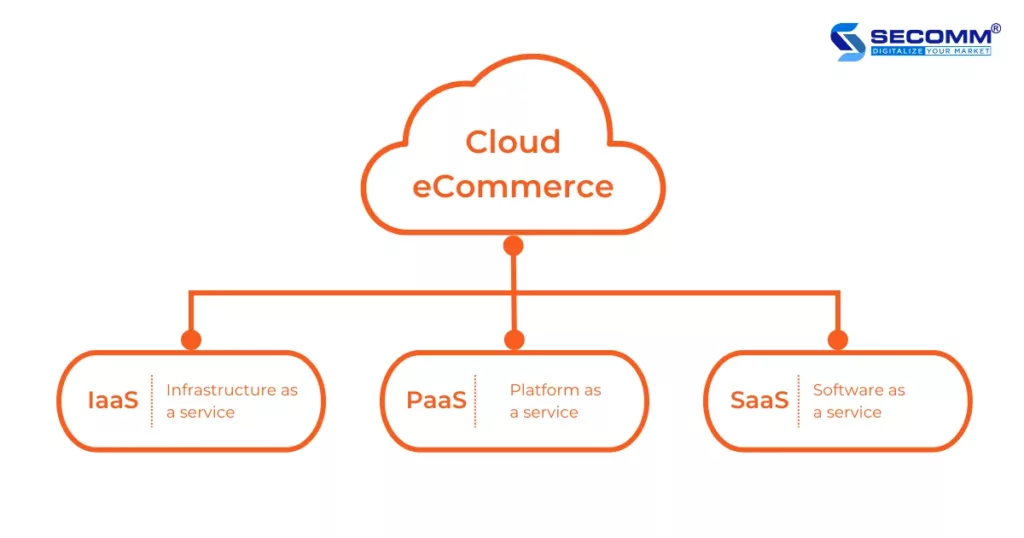
Infrastructure as a Service (IaaS) is where businesses rent physical resources such as servers, databases, and network equipment to build a sustainable eCommerce architecture. IaaS eCommerce focuses on providing on-demand data storage on disks and virtual servers, making it easy for businesses to use database services rather than dealing with hardware. However, businesses are responsible for managing applications, data, runtime, middleware, and the operating system on this infrastructure.
Notable IaaS providers include Amazon AWS, Microsoft Azure, and Digital Ocean. IaaS is suitable for businesses wanting full control over the system without the complexity of on-premise eCommerce.
Platform as a Service (PaaS) is similar to IaaS but requires less infrastructure management, allowing more time to build eCommerce applications using predefined infrastructure with pre-defined operating systems and processes to handle resources, planning, and error correction.
For example, Google App Engine provides a PaaS environment for developers to build web applications without worrying about infrastructure. PaaS eCommerce is suitable for businesses needing to build specialized eCommerce applications and are willing to eliminate infrastructure-related factors in their technology stack.
Software as a Service (SaaS) provides ready-made eCommerce services, including complete eCommerce solutions or individual eCommerce applications like Product Information Management (PIM) software, Order Management System (OMS), etc. SaaS eCommerce providers are responsible for managing both the infrastructure and software and businesses only need to configure the desired software. Additionally, SaaS eCommerce developers can work outside the user interface with APIs to develop custom solutions without the need for custom software development.
SaaS eCommerce is suitable for businesses that want to quickly deploy eCommerce solutions without significant involvement in infrastructure and software management.
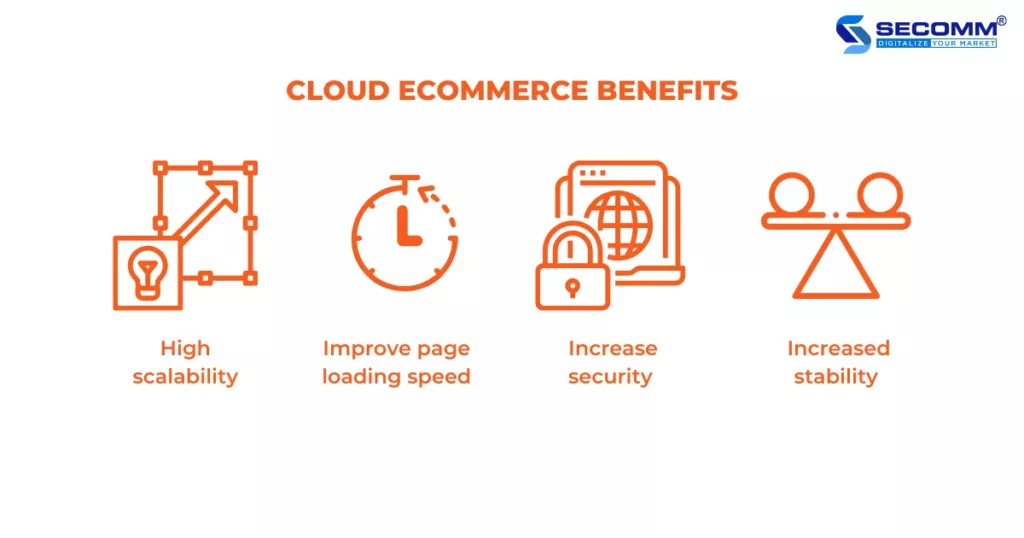
Cloud eCommerce inherits features from PaaS, making it easier to expand system functionality.
Typically, when fashion businesses start, they may not initially focus on scalability. However, from a strategic perspective, investing in technologies with scalability capabilities, such as Cloud eCommerce, can help businesses expand system functionality in each stage of eCommerce website development to foster business growth.
According to Think with Google, if a website takes up to 6 seconds to load, the probability of users bouncing increases by 106%. That’s why businesses need to focus on page load speed.
When an eCommerce website leverages Cloud eCommerce with data stored on a cloud platform, the speed of processing queries and API calls is significantly faster.
In the current era of the 4.0 technological revolution, the concern for data loss is a major focus for business leaders. As a response to this, numerous new technologies have emerged to address this goal.
According to PC Magazine, Cloud eCommerce provides control over data and storage locations, along with options such as physical backups and file synchronization to ensure data safety. Additionally, Cloud eCommerce supports businesses in obtaining PCI-DSS (Payment Card Industry Data Security Standard) certification, enhancing the credibility of their website.
Typically, businesses struggle to optimize storage capacity on their websites, especially when facing a massive surge in traffic during peak seasons, such as the “sale hunting” period. This sudden increase in workload poses a significant challenge to storage operations.
Cloud eCommerce offers a flexible solution to meet the demands of unpredictable spikes in traffic, whether seasonal or even hourly. It can dynamically scale up or down to support the real-time needs of a business. Overall, Cloud eCommerce is becoming a widely adopted technology in the digital transformation journey, helping businesses expand their functionality, improve page loading speeds, and enhance the security and stability of their websites.
However, mastering these new technologies requires programmers to possess a significant amount of specialized knowledge and hands-on experience with various complex projects. As a result, the costs associated with implementing Cloud eCommerce can be relatively high.
With over 9 years of experience designing complex eCommerce systems for companies like An Nam Gourmet, Laybyland, Jasnor, etc., SECOMM understands the challenges that businesses face when exploring new eCommerce technologies.
Contact SECOMM today for a free consultation on detailed eCommerce system development solutions!
 3
3
 11,635
11,635
 0
0
 2
2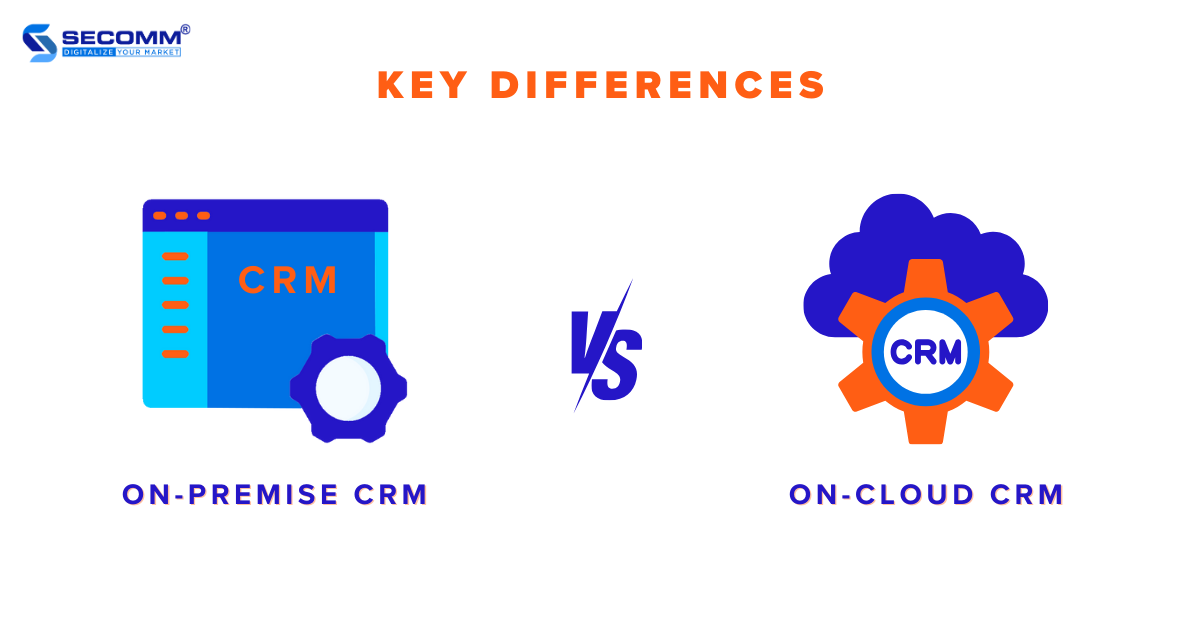
When it comes to Customer Relationship Management (CRM) software, businesses often have two choices: On-premise CRM and On-cloud CRM. This article will focus on clarifying the key differences and pros and cons of each option.
Understanding the distinctions between On-premise and On-cloud CRM can help businesses make well-informed decisions, optimize customer relationship management, and succeed in today’s business landscape.
Related Reading: What is CRM? Top 5 benefits of using CRM software in 2023
On-premise CRM is a type of CRM software installed and hosted on the servers and infrastructure owned by the business. When deploying On-premise CRM, the business takes responsibility for all aspects of the CRM system, including hardware, software, maintenance, security, and database management.
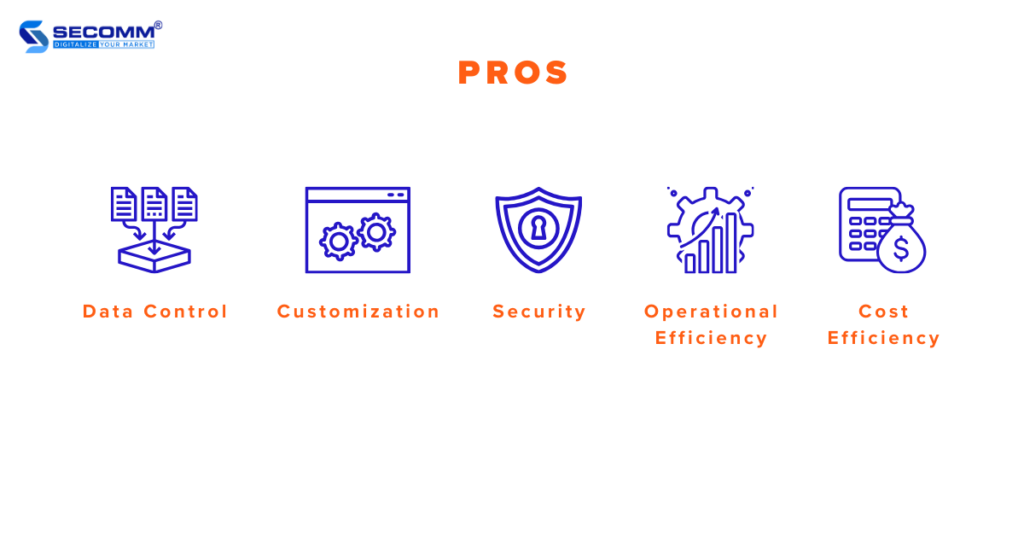
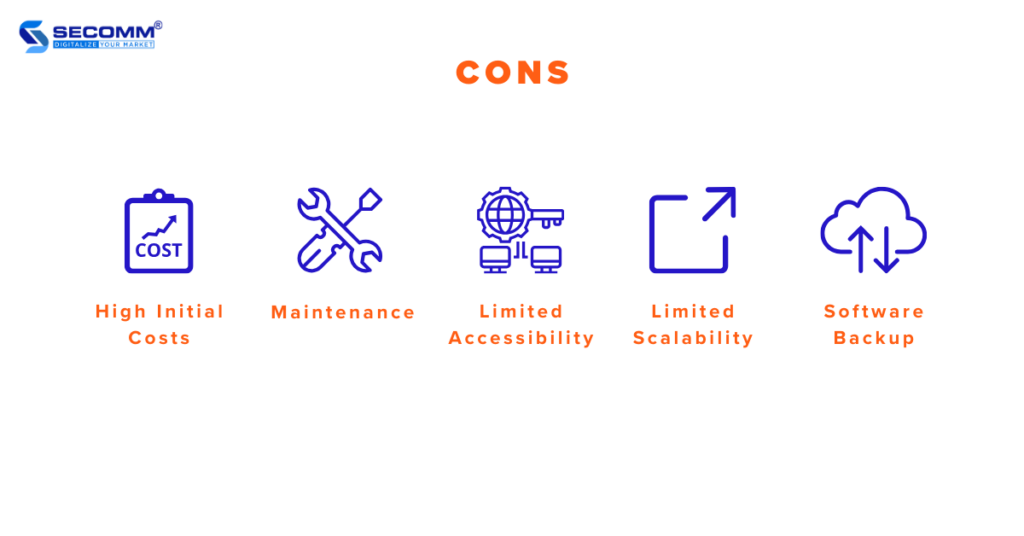
Some popular on-premise CRMs like Microsoft Dynamics, Oracle Siebel CRM,…
On-Cloud CRM is a form of customer relationship management software hosted on the remote servers of a third-party provider. With this software, businesses are relieved from the task of managing and maintaining fundamental infrastructure like servers and central databases, as those responsibilities are handled by the On-Cloud CRM provider.
Businesses can access the CRM system from anywhere with an internet connection through a web browser or mobile application.
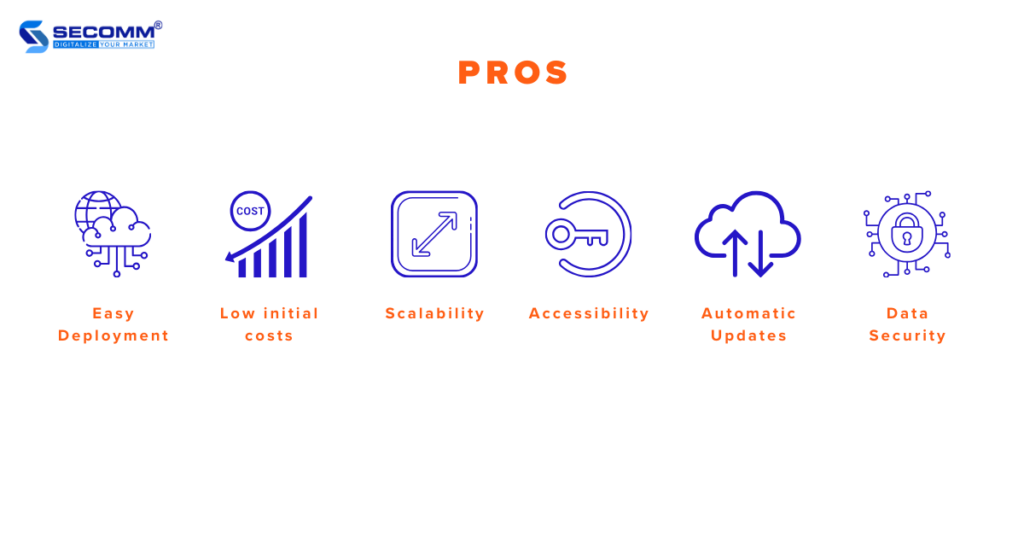
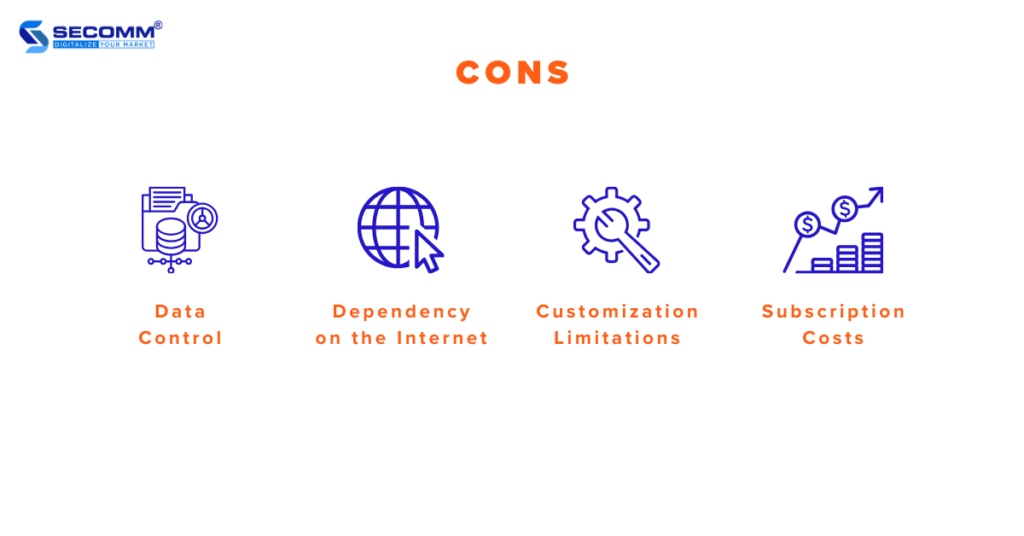
Some popular Cloud CRMs include Salesforce Sales Cloud, SAP Sales Cloud, Oracle CRM On Demand,…
Related Reading:
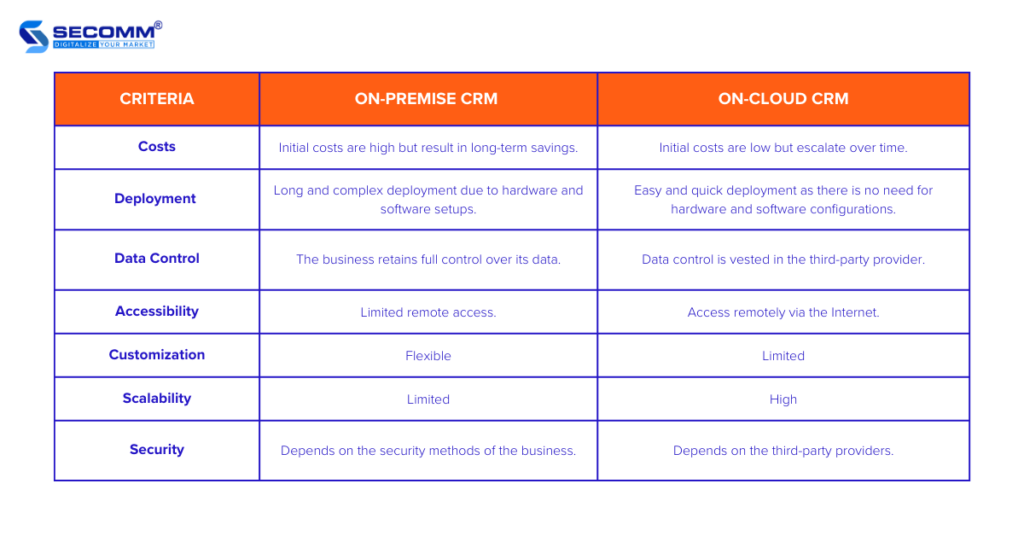
The choice between On-premise and On-cloud CRM becomes a crucial decision in the strategy of deploying CRM. Each type comes with its own set of advantages. On-premise CRM offers high control and customization, while On-cloud CRM is convenient, flexible, and helps reduce the burden of infrastructure and initial costs.
The ultimate decision depends on the deployment needs, data control requirements, and budget. Nevertheless, both can serve as valuable tools for businesses to manage customer relationships and amplify operational efficiency.
Contact SECOMM or call the hotline at 02871089908 today to learn more about deploying and developing a comprehensive CRM system and determine the optimal choice between On-premise and On-cloud.
 2
2
 13,538
13,538
 0
0
 1
1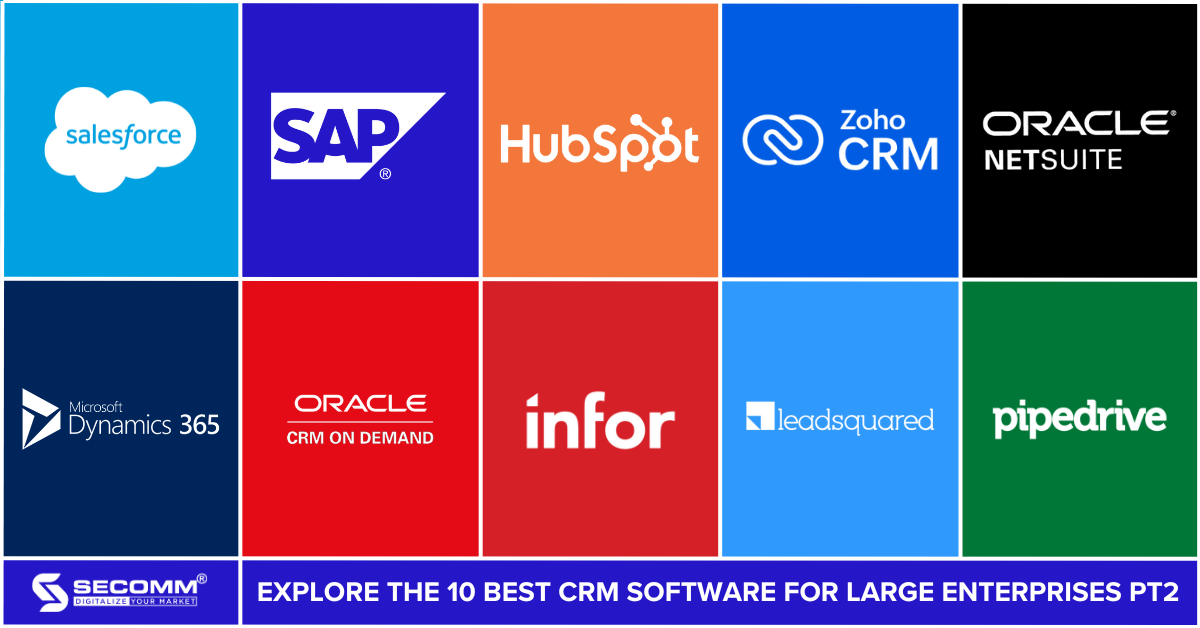
The recent surge in prioritizing customer experience has significantly impacted the evolution of eCommerce. Therefore, choosing the right CRM among various CRM software solutions to effectively manage customer relationships is crucial.
Following Part 1, here are 5 other CRM software options for large enterprises worth considering.
Dynamics 365 Sales is a comprehensive Customer Relationship Management (CRM) solution developed by Microsoft. The software is designed to assist businesses in managing and streamlining customer interactions, enhancing the sales process’s efficiency.

Its notable capability for scalability and flexible customization has made Dynamics 365 Sales one of the most suitable choices for the complex deployment needs of large enterprises.
Core features:
Costs:
| Dynamics 365 Sales Professional | Dynamics 365 Sales Enterprise | Dynamics 365 Sales Premium | Microsoft Relationship Sales |
| $65/user/month | $95/user/month | $135/user/month | $162/user/month |
Pros:
Cons:
Oracle CRM On Demand is a cloud-based CRM designed to assist businesses in managing sales activities, marketing, and customer interactions, and providing in-depth analytical reporting. It is the SaaS version of Oracle’s renowned on-premise software, Siebel CRM. Businesses can use both of these software applications and link them through the ‘Oracle Application Integration Architecture’ and ‘Oracle Fusion Middleware’ software.
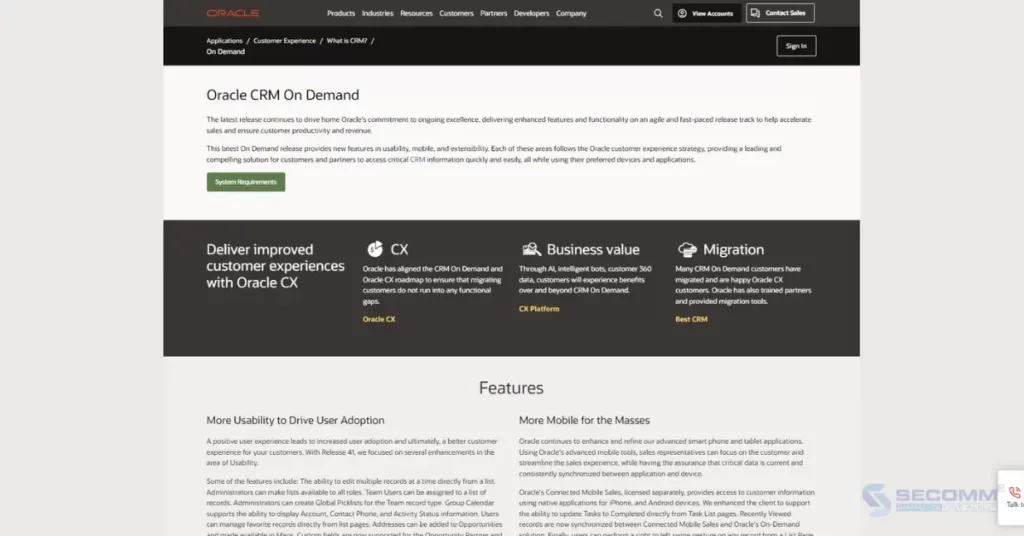
Core features:
Costs: Oracle CRM On Demand doesn’t publicly disclose its pricing on the website. Therefore, businesses are advised to contact the provider directly for consultation and a price quote.
Pros:
Cons:
Related Reading: On-Premise CRM vs On-Cloud CRM: Key Differences
Infor CRM is a cloud-based customer relationship management (CRM) software designed to assist large businesses in developing and maintaining customer relationships.
Infor CRM is known for its flexibility, scalability, and high configurability, offering a range of features to help businesses better understand their customers, personalize customer experiences, and enhance the effectiveness of sales operations.
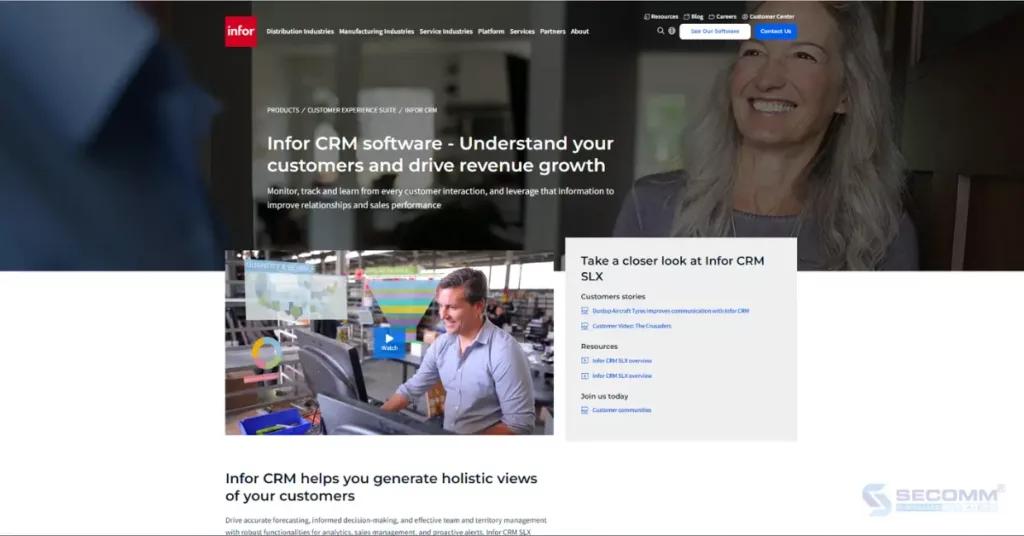
Core features:
Costs: Infor CRM doesn’t publicly disclose its pricing on the website. Therefore, businesses are advised to contact the provider directly for consultation and a price quote.
Pros:
Cons:
LeadSquared Sales + Mobile CRM is a cloud-based CRM solution that enables businesses to enhance sales productivity and manage relationships with customers and potential customers.
This CRM solution integrates the features of Sales CRM and Mobile CRM, allowing businesses to access customer data and perform essential sales tasks from anywhere, at any time.
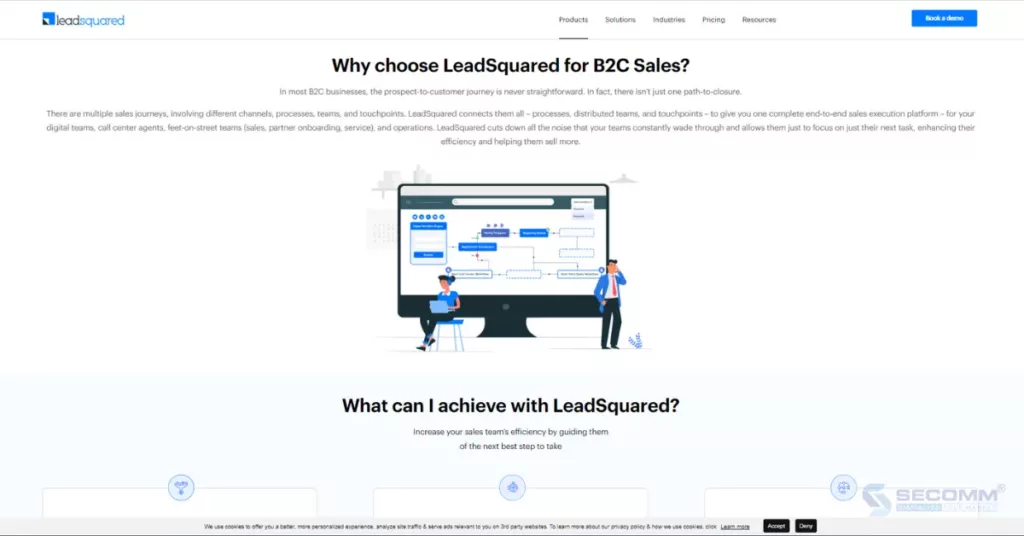
Core features:
Costs:
| Lite | Pro | Super | Ultimate |
| $25/user/month | $50/user/month | $100/user/month | Custom |
Pros:
Cons:
Pipedrive is a popular CRM software solution used by businesses of all sizes and industries. In recent times, large enterprises have shown particular favor for Pipedrive CRM due to its advanced features that assist in managing sales opportunities and swiftly converting potential customers into clients.
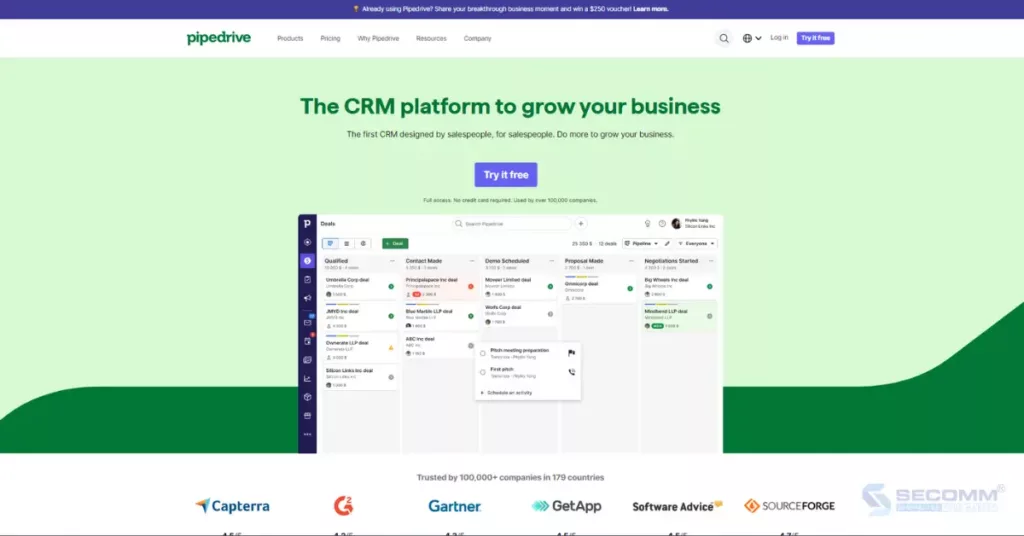
Core features:
Costs:
| Pricing plans | Essential | Advanced | Professional | Power | Enterprise |
| Billed Monthly | $15/user/month | $29/user/month | $59/user/month | $69/user/month | $99/user/month |
| Billed Yearly | $12.50/user/month | $24.90/user/month | $49.90/user/month | $59.90/user/month | $74.90/user/month |
Pros:
Cons:
Choose the best CRM software!
So, the article about the 10 CRM software systems part 1 + part 2 has come to a close with the hope that businesses will choose a platform suitable for their development needs.
By implementing a CRM solution, businesses can quickly build and develop relationships with customers while enhancing collaboration among internal departments.
Contact or call SECOMM’s Hotline directly at (02871089908) for advice and CRM implementation.
 2
2
 13,430
13,430
 0
0
 1
1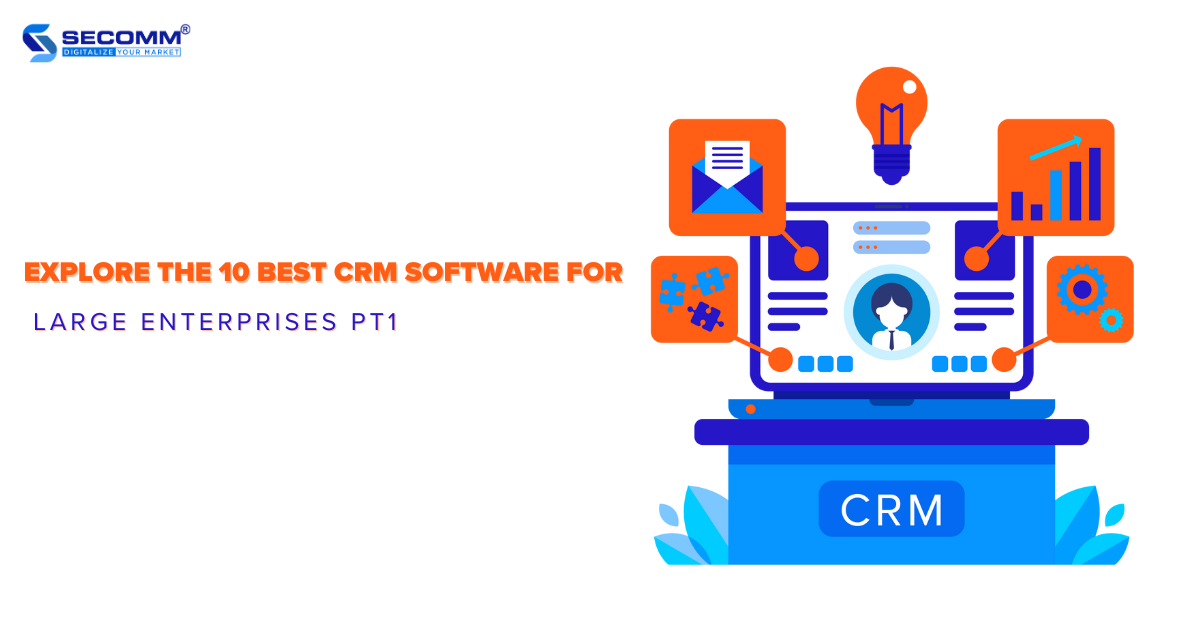
The options for CRM solutions are expanding and becoming more diverse. In reality, some currently popular CRM software may lack the flexibility to meet the complex deployment requirements of large businesses.
Nevertheless, there are CRM software designed to offer a digital infrastructure, in-depth technical support, and exceptional features, granting significant customization freedom for large enterprises.
The article below focuses on providing important considerations when choosing CRM solutions and lists the 5 best enterprise CRM software.
The first important step before selecting CRM software is to clarify the needs and deployment expectations. You can review and assess the pros and cons of the current tools and management programs in use. Following this, the focus should be on the aspects requiring modification or enhancement, all while estimating the customization needs.
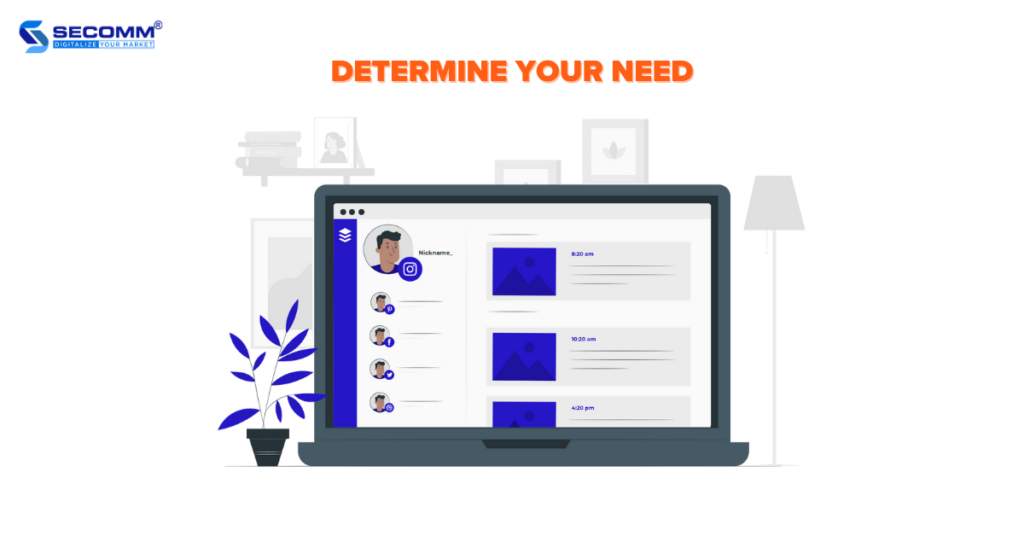
Next, you need to the type of software to deploy, which may be either On-premise or On-cloud CRM software. These two software types come with key differences.
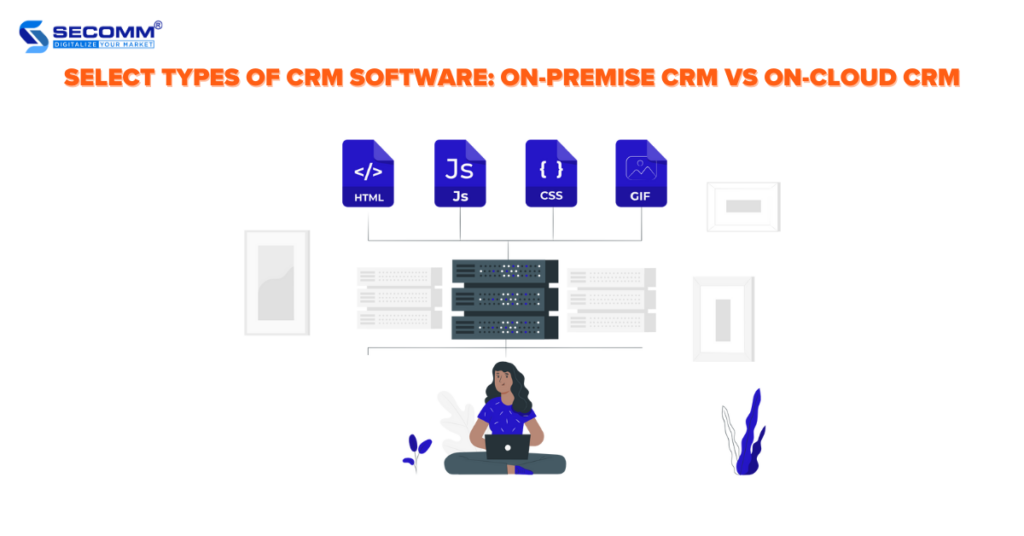
For On-cloud CRM, the entire data and software system are stored and managed by a third-party service provider, allowing you to access it through a web browser or mobile application.
Some advantages of On-cloud CRM include:
On the other hand, On-premise CRM stores and manages the entire data and software system locally on the company’s servers and infrastructure.
Some advantages of On-premise CRM include:
Related Reading: On-Premise CRM vs On-Cloud CRM: Key Differences
A user-friendly CRM software accessible to users of all skill levels contributes to expediting the deployment process effectively. Specifically, the software interface should be intuitive, easy to install, and allow for seamless import and export of any data type without requiring excessive assistance.
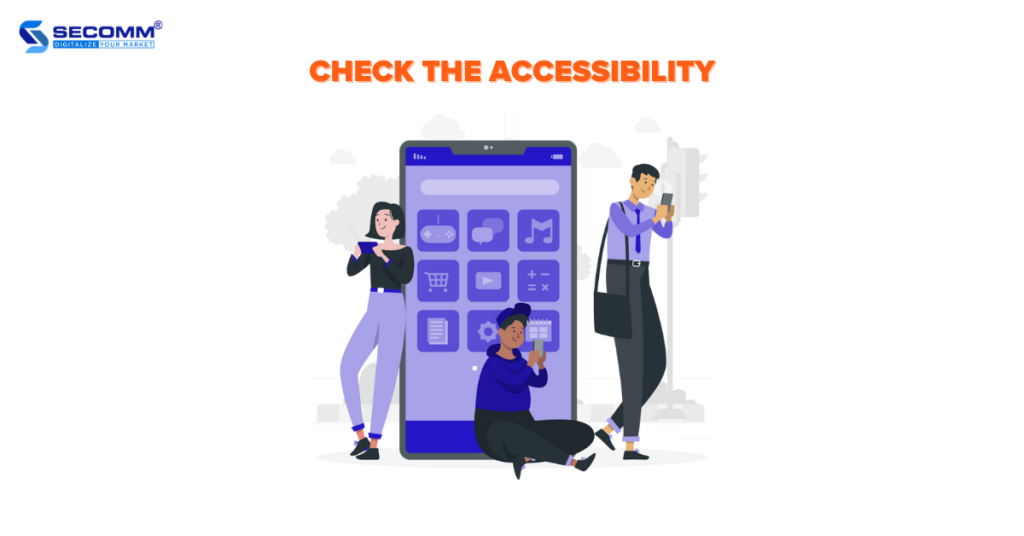
Moreover, businesses should opt for CRM software that is flexible enough to synchronize with their existing operational processes. Typically, the majority of CRM solutions nowadays offer a free trial period of three or four weeks. This timeframe is sufficient for businesses to understand the software’s functionality and assess whether it is the optimal choice for their deployment needs.
Customization is a vital feature of CRM software. Because each business has different models and scales, it’s essential to select CRM software that offers customization capabilities to match your business requirements and smoothly manage your sales processes.
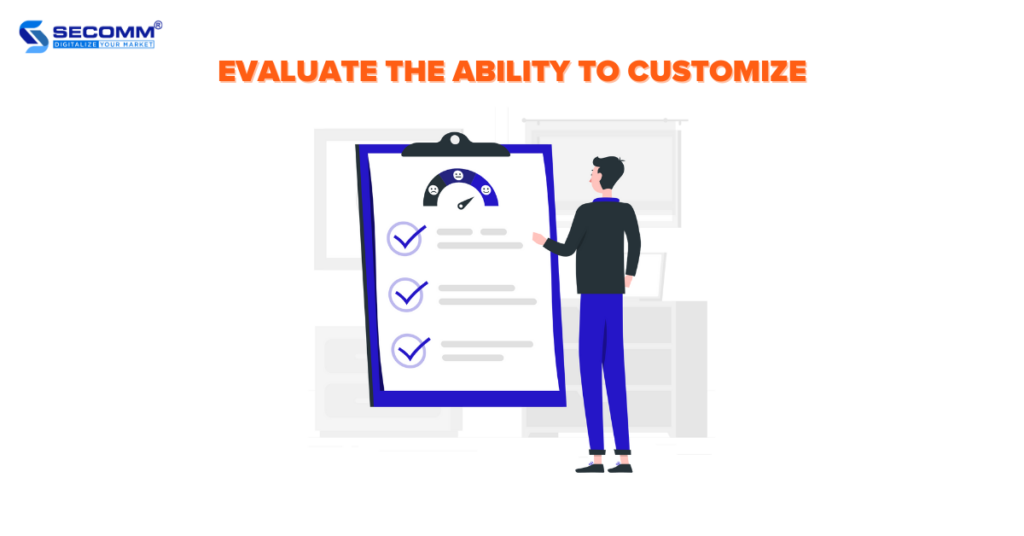
Most CRM software designed for large-scale businesses offers customization capabilities. Nevertheless, while CRM solutions with extensive customization features can facilitate flexible deployment to meet specific needs, they often come with a higher price point.
The most crucial information stored in CRM software is customer data. Therefore, when selecting a CRM solution, you need to prioritize security.
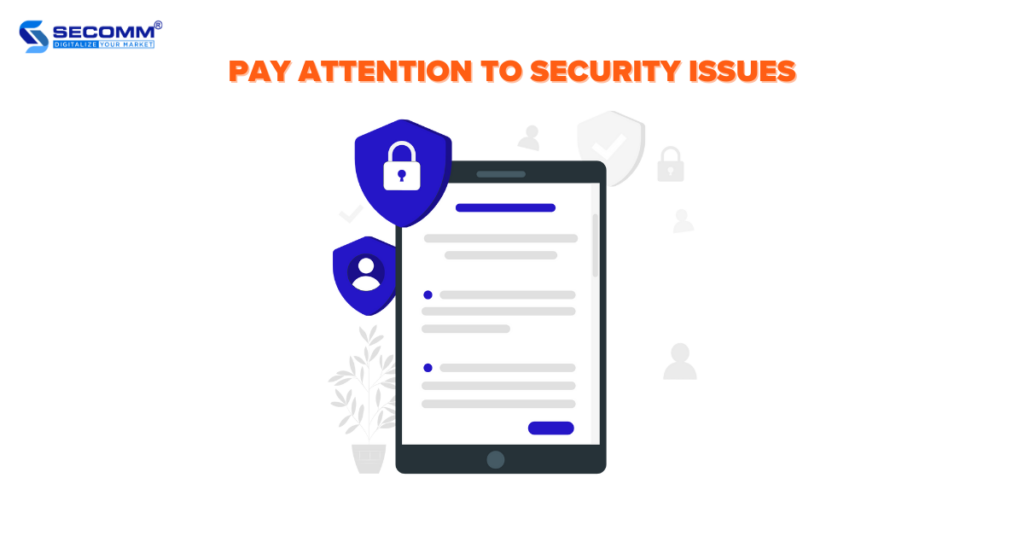
Currently, many CRM solutions are cloud-based, meaning customer data is encrypted and regularly backed up to enhance safety and security. However, you should thoroughly research the provider and understand how their data will be stored and secured in the database. This information is typically available on the CRM provider’s website.
According to G2‘s and rankings based on user satisfaction, here are the top 10 CRM software solutions best suited for large-scale enterprises.
Salesforce Sales Cloud is a part of the renowned Salesforce CRM platform, developed to assist large enterprises in optimizing business operations and maintaining better customer relationships.
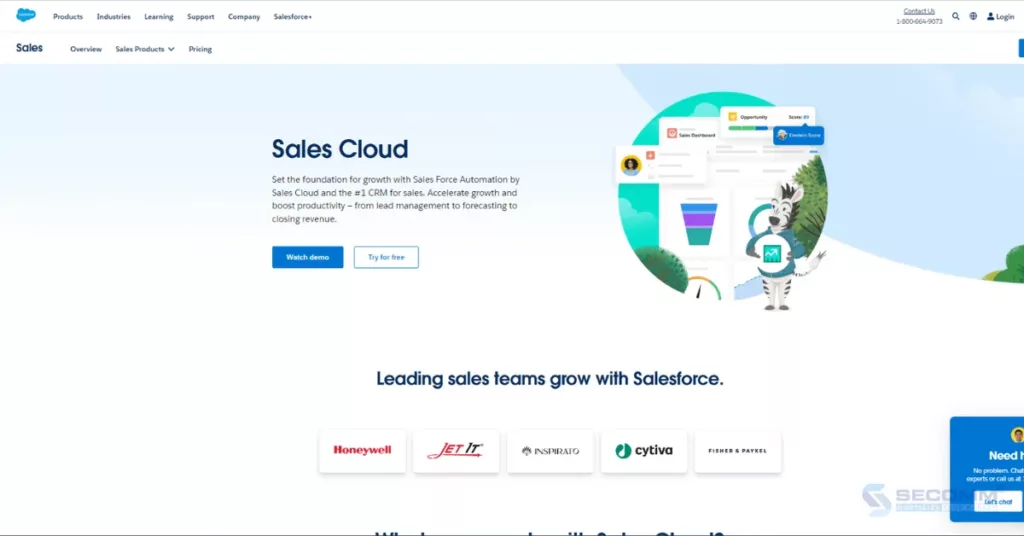
Core features:
Costs:
| Essentials | Professional | Enterprise | Unlimited |
| $25/user/month | $75/user/month | $150/user/month | $300/user/month |
| For small businesses with a maximum of 10 users. | For businesses of all sizes. | For large enterprises with deep customization needs. | For large enterprises with unlimited software usage and demanding support requirements. |
Pros:
Cons:
Recognized as a top on-cloud CRM software for large enterprises, SAP Sales Cloud assists businesses in creating an internal collaborative environment, optimizing business processes, and fostering efficient interactions with customers.
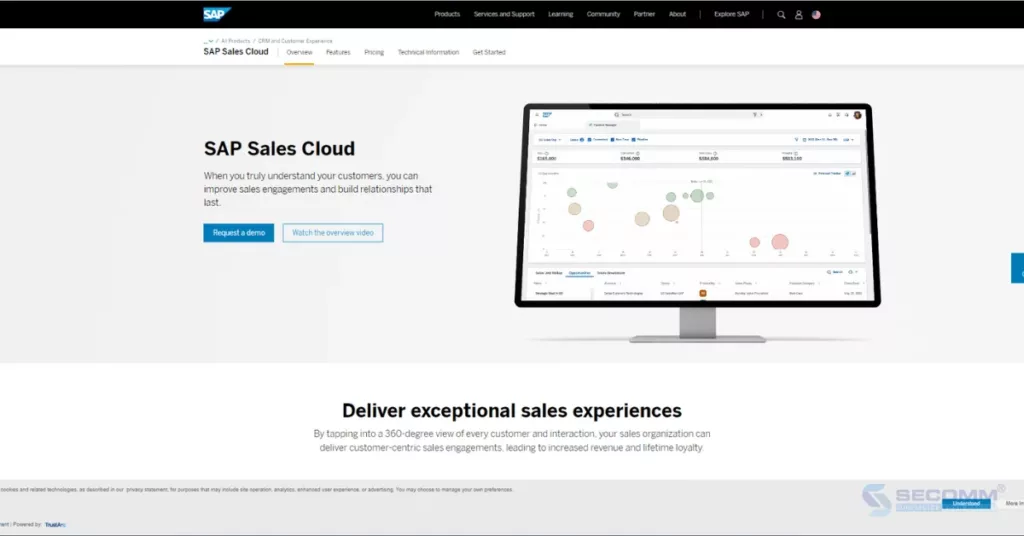
Core features:
Cost: SAP Sales Cloud doesn’t publicly disclose its pricing on the website. Therefore, businesses are advised to contact the provider directly for consultation and a price quote.
Pros:
Cons:
When it comes to leading CRM providers, HubSpot is a very familiar name for most businesses. The HubSpot Sales Hub solution offers businesses outstanding features to build relationships with customers, manage the sales funnel effectively, and close more deals.
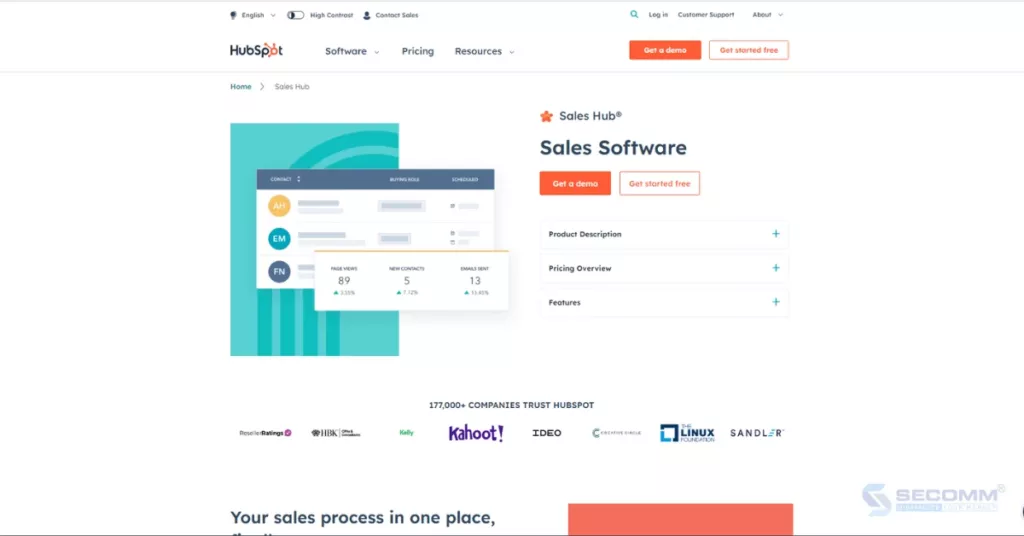
Core features:
Costs:
| Free | Starter | Professional | Enterprise |
| 100% Free | $45/month | $450/month | $1200/month |
Pros:
Cons:
Zoho is a renowned CRM solution with a variety of features designed to suit businesses of all sizes, enabling them to build and manage customer relationships and optimize sales processes.
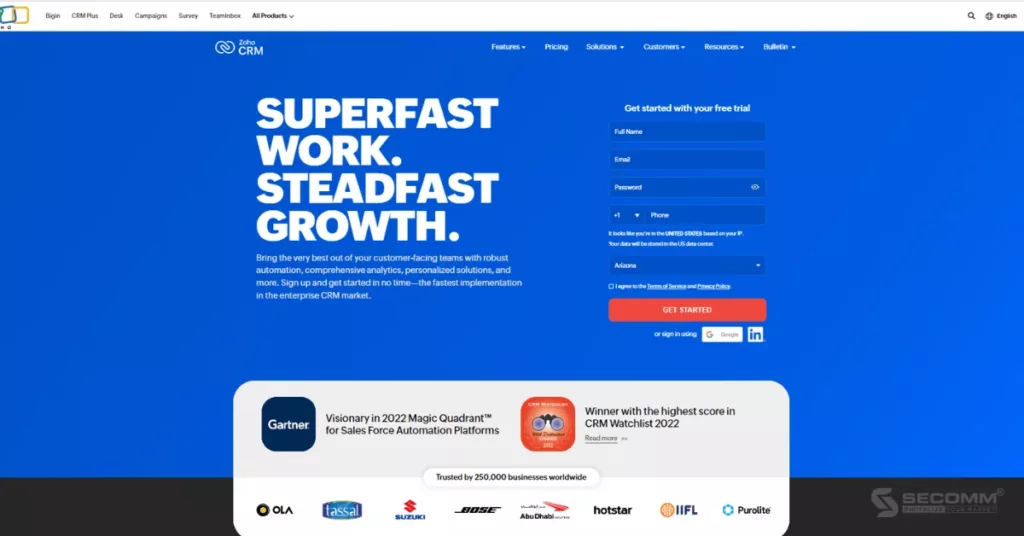
Core features:
Costs:
| Pricing plans | Standard | Professional | Enterprise | Ultimate |
| Billed Monthly | $20/user/month | $35/user/month | $50/user/month | $65/user/month |
| Billed Yearly | $14/user/month | $23/user/month | $40/user/month | $52/user/month |
Pros:
Cons:
Another prominent CRM software for large enterprises is NetSuite CRM. This is a cloud-based CRM platform designed to help businesses manage interactions with current and potential customers, partners, and suppliers.
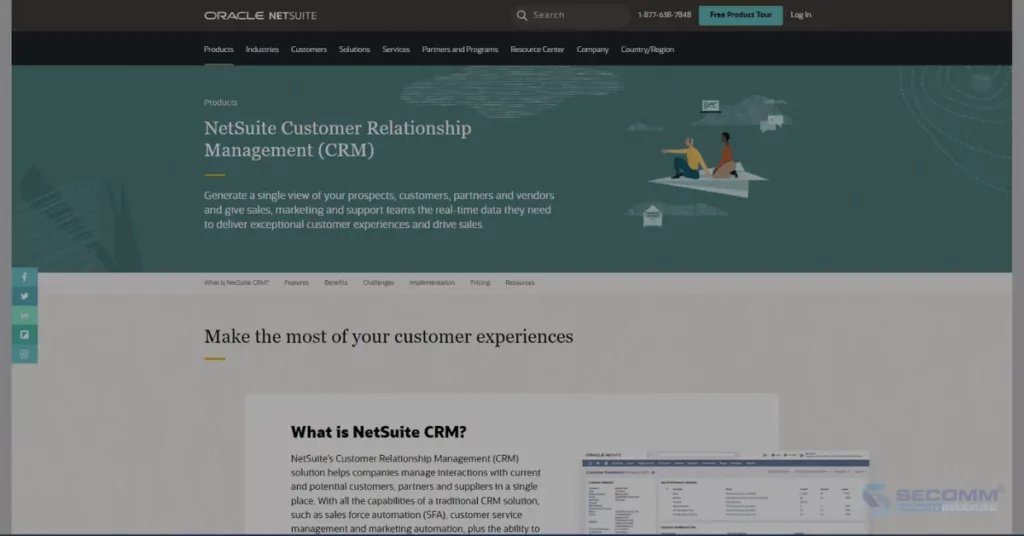
Core features:
Costs: NetSuite CRM doesn’t publicly disclose its pricing on the website. Therefore, businesses are advised to contact the provider directly for consultation and a price quote.
Pros:
Cons:
Related Reading: Explore the 10 best CRM software for large enterprises Pt2
The Bottom Line
Leveraging years of valuable experience supporting various businesses in the deployment of CRM solutions, SECOMM offers valuable insights to help businesses swiftly identify appropriate software and expedite the implementation process.
Contact or call directly to SECOMM’s hotline at 02871089908 for free consultation.
 2
2
 8,296
8,296
 2
2
 1
1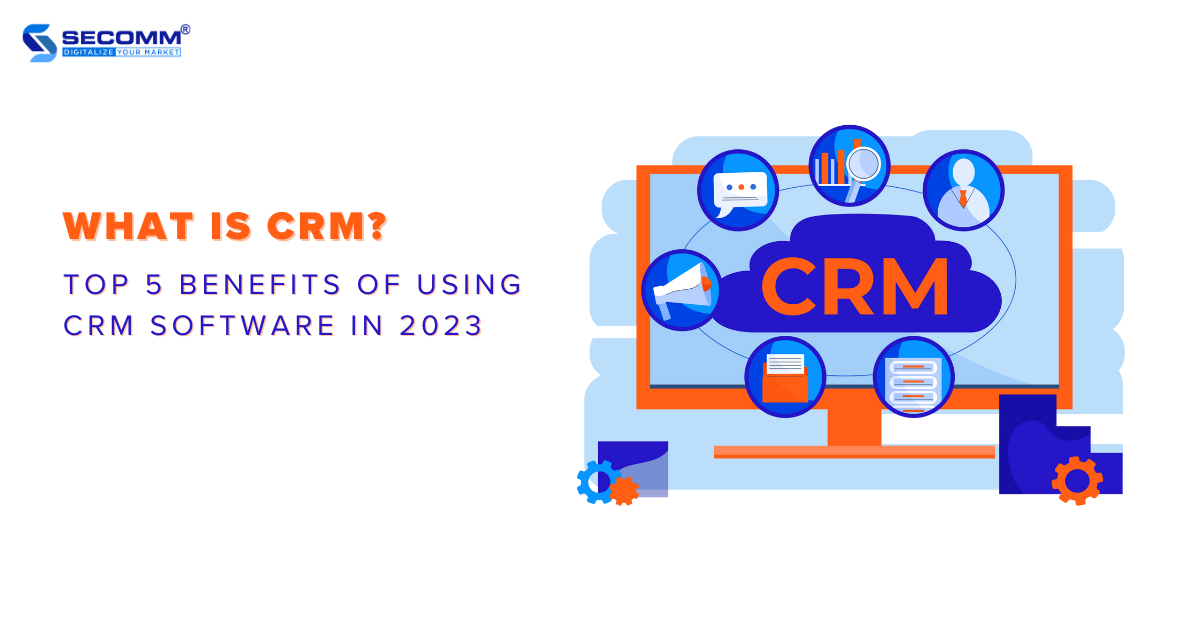
According to Fortune Business Insight, the projected value of the global Customer Relationship Management (CRM) market for 2023 stands at $71.06 billion, with expectations to surge to around $157.53 billion by 2030, exhibiting a Compound Annual Growth Rate (CAGR) of 12%.
CRM, a software solution, delivers numerous advantages for both sellers and buyers. This tool empowers businesses to forge enduring, meaningful relationships, yielding substantial profits. Meanwhile, customers can enjoy personalized and high-quality experiences.
The following article delves into the detailed definition of CRM, common types of CRM software, core features, and the benefits when businesses use CRM solutions.
CRM or Customer Relationship Management is a software solution crafted to help businesses efficiently manage their relationships with both current customers and potential leads.
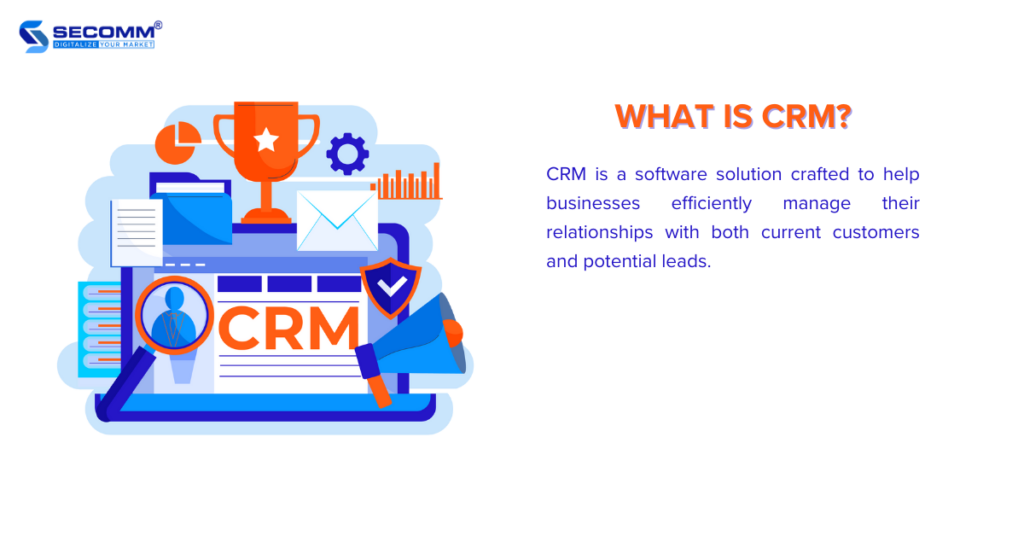
The CRM system is designed to carry out specific tasks, including:
By utilizing CRM software, businesses can eliminate the need for using scattered spreadsheets and apps. This helps overcome limitations, offering robust features for performance analysis and gaining insights into customer interactions.
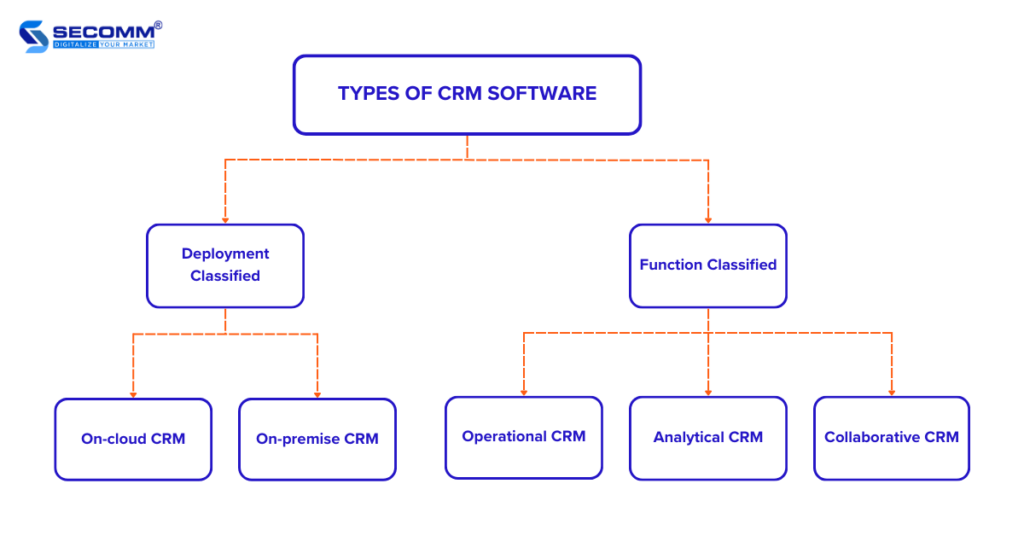
Related Reading: On-premise CRM vs On-cloud CRM: Key Differences
These CRM systems are crafted to help businesses manage sales, marketing, and customer service activities. The main goal of CRM software is to generate a pool of new potential customers, nurture these leads, convert them into loyal customers, and retain them through effective marketing strategies and top-notch customer service.
While the Operational CRM system helps businesses enhance customer attraction and retention, the Analytical CRM system allows businesses to understand how potential customers move through the sales funnel. These CRM solutions gather, store, and analyze customer data, delivering detailed insights into customer interactions with the business.
This facilitates businesses in assessing the effectiveness of marketing, sales, and customer care initiatives, allowing them to make necessary adjustments.
The main goal of Collaborative CRM software is to improve customer experience and streamline business processes by enabling communication and data sharing among internal departments and external stakeholders (suppliers, partners).
While operational and analytical CRM systems also allow for data sharing, collaborative CRM places a greater emphasis on enhancing the customer experience.
It is especially favored by businesses with extensive customer databases that necessitate tight collaboration between departments (sales, marketing, customer care) to ensure the optimal customer experience.
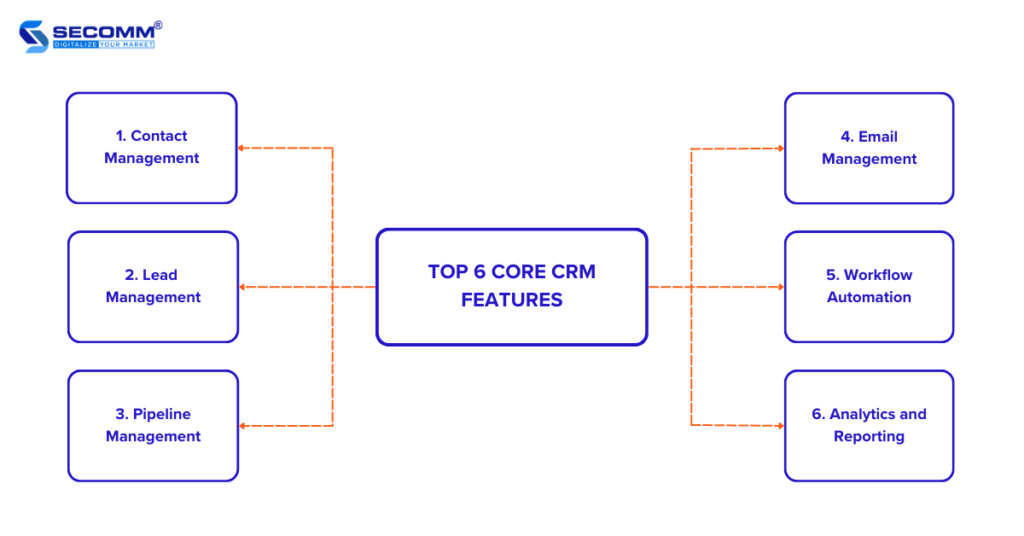
The first important feature to mention in CRM software is Contact Management. This feature allows businesses to store information related to customers and potential customers on the platform, ranging from their names, phone numbers, email addresses, and job details to more in-depth data such as interaction history and how each customer interacts with the business.
Lead Management is one of the core CRM features. This feature supports marketing and sales efforts by:
The Pipeline Management feature provides businesses with a visual overview of potential customers and existing transactions. Deals are separated into different stages of the pipeline. This helps sales representatives understand the status of each potential customer and aids them in deciding which leads to pursue.
Utilizing the Email Management feature, businesses can seamlessly integrate their email functionality with CRM software, facilitating the sending and receiving of emails directly within the CRM system interface.
This streamlined approach saves time, eliminating the need to navigate between various tabs for email communication and ensuring no missed opportunities to engage with potential customers.
The next crucial feature in CRM solutions is Workflow Automation, which comprises three fundamental aspects: Marketing Automation, Sales Automation, and Customer Service Automation.
Marketing Automation
The ‘Marketing Automation’ feature helps businesses simplify the marketing process by designing trigger elements for specific actions of customers and potential customers, such as:
In summary, the automated marketing process in the CRM system utilizes the “if-then” logic to automatically trigger interactive activities after customers or potential leads perform specific actions.
Sales Automation
Similar to ‘Marketing Automation,’ the ‘Sales Automation’ feature also uses trigger elements to help sales representatives automatically provide purposeful interactions with customers at specific points in the sales process.
Additionally, Sales Automation assists sales representatives in scoring and managing potential customers, while automatically generating sales forecast reports, enabling businesses to make informed decisions.
Examples of sales automation process:
Customer Service Automation
‘Customer service automation’ in CRM solutions refers to the use of automation technologies to enhance and optimize the customer service experience.
This may include using chatbots for online support, sending automatic notifications and updates to customers, automating the handling of basic customer requests and inquiries, and various other activities to save time and streamline workflows.
The ‘Analytics & Reporting’ feature in CRM solutions plays a crucial role in analyzing data and generating reports to help businesses gain a deeper understanding of their business performance, customer interactions, and market trends.
This is an important tool that enables businesses to make decisions based on accurate data, improve customer interactions, and optimize business strategies.
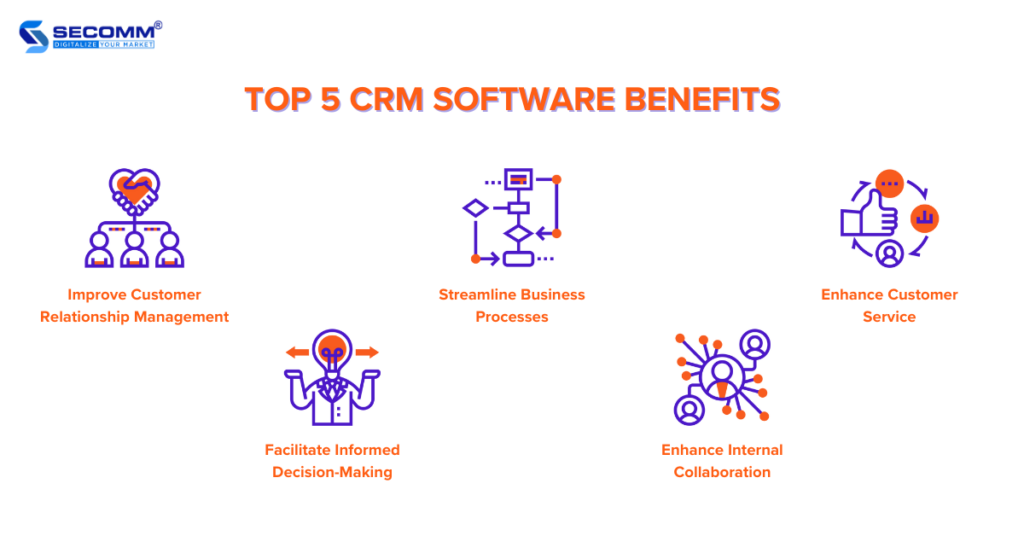
CRM software plays a pivotal role in enabling businesses to gather and store comprehensive information about customers, including interaction history and personal details. This helps understand customers and creates a personalized interaction experience, from providing better services to developing appropriate outreach strategies.
CRM systems help automate many aspects of the business process, such as sales management, marketing, and customer interaction tracking. This results in increased work efficiency, minimizes errors and enhances the ability to interact effectively with customers.
CRM platforms provide tools such as automated chatbots and customer support systems, facilitating the swift resolution of customer requests and inquiries. This enhances the customer experience, builds trust, and increases the chances of establishing long-term relationships
The CRM software’s data analysis features contribute to a more profound comprehension of customer behavior, business performance, and emerging market trends. This empowers businesses to make informed decisions and anticipate future developments.
CRM software facilitates tight collaboration among different departments within a business, working together on the platform. This encourages the exchange of information and internal interactions, ultimately enhancing data consistency, feedback capabilities, and accurate responsiveness to customer needs.
There’s no doubt that CRM software offers incredible benefits to businesses. From efficiently managing customer relationships to optimizing business processes and providing the best customer experience. CRM is not just a tool but a viable strategy that helps businesses build and maintain relationships with their customers.
Over the years, SECOMM has been accompanying many clients in developing CRM solutions. We have observed that in a competitive business landscape, choosing the appropriate CRM software is as crucial as understanding customers and implementing CRM strategies.
Contact SECOMM or call the hotline at (+84)28 7108 9908 for a free consultation.
 2
2
 9,981
9,981
 0
0
 1
1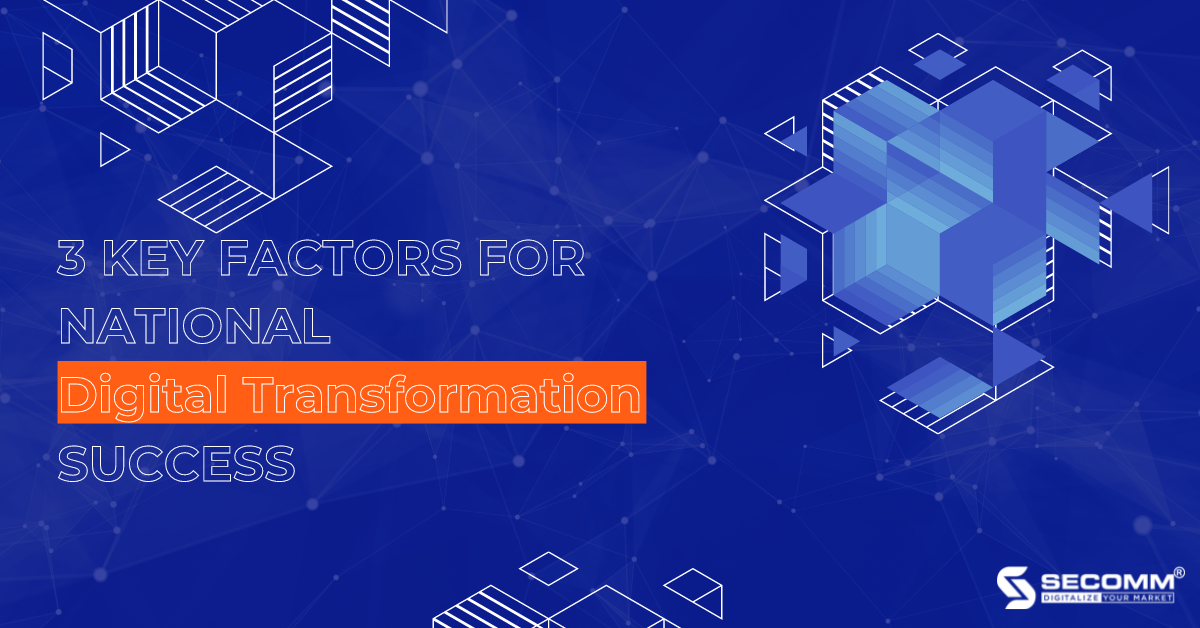
When the Prime Minister approved the “National Digital Transformation Program to 2025, with a vision to 2030,” national digital transformation became formally a goal shared by the entire Vietnamese people in 2020.
Since then, localities, ministries, branches, and even the government have all gradually incorporated the term “Digital Transformation” and applications of digital technology into their everyday activities.
Thus, we all realize the significance and impact of the digital transformation trend. What essential elements, nevertheless, determine the National Digital Transformation Program’s success or failure?
The process of using digital technology to completely alter each person’s lifestyle, each company’s business model, and each nation’s government operations in order to create new values and prospects for future development is referred to as transformation, also known as digital transformation.
Today, all businesses, big and small, have to decide whether to embrace innovation or risk lagging behind, becoming ineffective, and going out of business.
Furthermore, digital transformation involves- not just comprehending and utilizing technology but, more importantly, reinventing the complete business strategy as well as the vision and development priorities of the nation in relation to the global development trend.
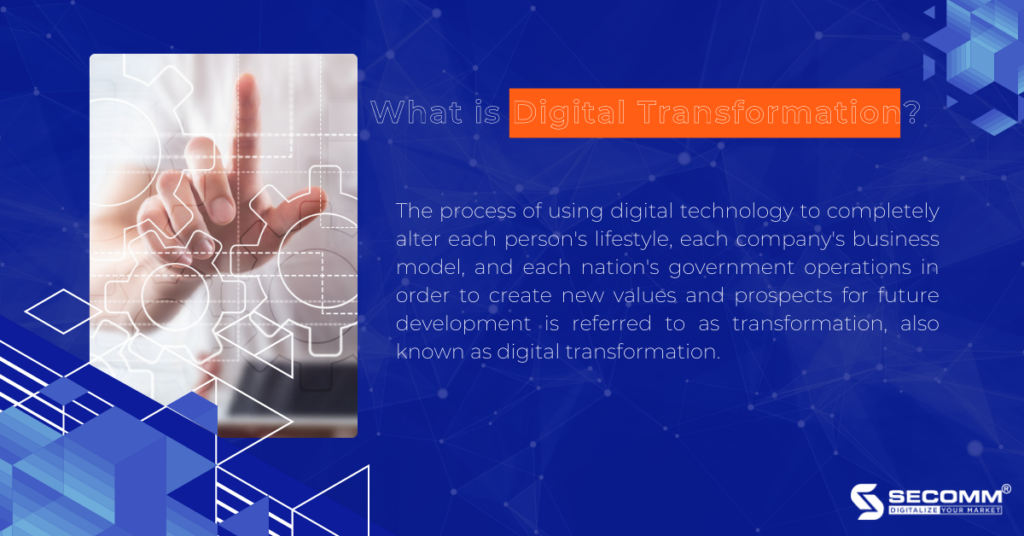
According to data from Mordor Intelligence, the digital transformation age is shining in practically “every nook” of the global economy, confirming that this is not a “soon to fade” trend but rather a new and sustainable development orientation following the pandemic crisis.
In Vietnam alone, the government has established a National Digital Transformation Program for 2025, with a vision to 2030, with particular targets to shorten the distance with other countries around the world, including:
The fact that the goals are stated in great detail in the national digital transformation program with a focus on 2030 demonstrates how seriously the Vietnamese government takes the significance of digital transformation for the prosperous growth of the nation.
Think about the global Industrial Revolution 4.0 wave that is currently in motion. With the aid of connection provided by the Internet of Things (IoT), real-time data access, and the introduction of cyber-physical systems, the Industrial Revolution 4.0, also known as Industry 4.0, primarily focuses on advancing modern digital technology to an entirely new level.
Every Government, organization, corporation, and individual throughout the world must transform its business model, and the manner of working from non-digital to digital operation, in order to keep up with this current technology and immerse itself in the Industry 4.0 wave. The name of this procedure is “digital transformation”.
Vietnam, despite having a minor economy compared to other countries, is a crucial part of the massive Industrial Revolution 4.0 that is currently underway. Vietnam must therefore undergo a digital transformation in order to compete.
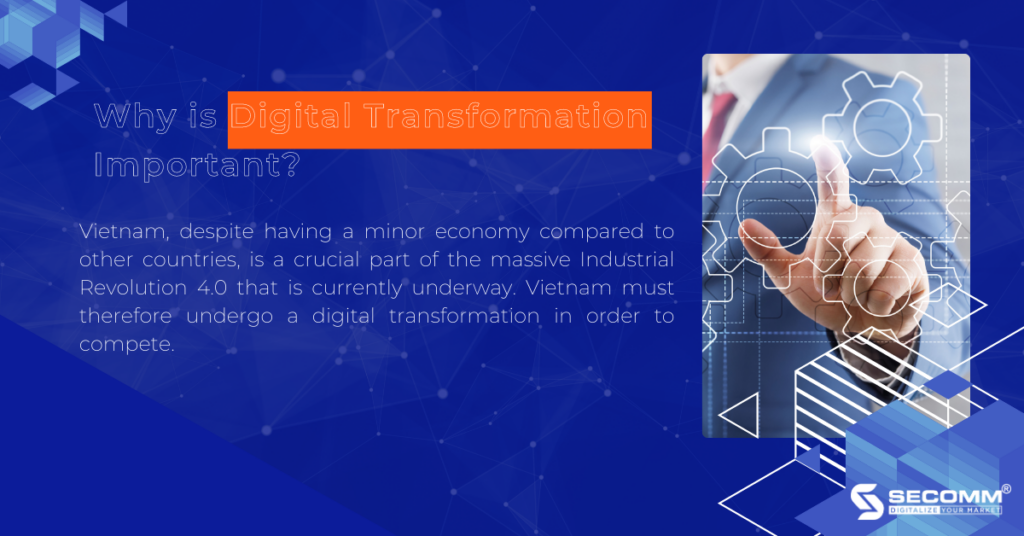
The goal will be challenging to accomplish if just businesses execute digital transformation because the capital and costs are quite high; therefore, businesses require assistance from the government budget and outside finance.
On the other hand, even with a massive budget, it can be challenging for businesses to implement effective digital transformation if the government does not go digital, but continues to run in the old manner, handles administrative procedures slowly, lacks direction, and supports businesses clearly and methodically.
Furthermore, without the support of the people, the National Digital Transformation process to catch up with the global Industry 4.0 wave will be impossible. However, the public needs the government to inform, direct, and inspire digital transformation.
Also, businesses must create useful digital transformation strategies that both before and after implementation considerably raise people’s quality of life.
Vietnam must structure three main areas of digital transformation: the government, businesses, and people, or in other words, the digital government, digital economy, and digital society, if national digital transformation is the outcome it seeks to achieve in order to gradually join the Industrial Revolution 4.0.
These three crucial overlapping and interdependent relationships make up the National Digital Transformation.
Throughout the earlier years, Vinasa reports that in 2019, 40.6% of organizations and businesses confirmed that they have resources available for digital transformation and that 23.6% of them are putting it into practice. However, 30.7% of them are uncertain of what to do despite doing some research, and 38% are unsure of where to begin.
Due to the Prime Minister’s approval of the “National Digital Transformation Program to 2025, with a vision to 2030” and the abrupt change brought on by the impact of the global pandemic, Digital Transformation is now regarded as the process’ starting year. This makes it a top priority to maintain Vietnam’s economy.
The government and Vietnamese enterprises have been able to promote awareness of the importance and urgency of digital transformation in order to help the country overcome the obstacle thanks to the economic crisis brought on by the effects of the Covid-19 outbreak.
According to the UN, Vietnam’s digital government statistics are better than the average for the area. Vietnam specifically saw a rise of 2 places in 2020, moving up to rank 86th out of 193 UN member states globally and 6th out of 11 Southeast Asian nations.
The establishment of the National Digital Transformation Committee and the decision to appoint October 10 of each year as National Digital Transformation Day in accordance with the National Digital Transformation policy for a better life for the people are two additional significant events that will forever be remembered in Vietnam in the years 2021 and 2022.
As a result, leaders and people are more conscious of the significance, function, and advantages of digital transformation, and there are coordinated actions throughout the entire system, from the government to the general populace.
According to data from the Ministry of Information and Communications, the databases that Vietnam has built up to the second quarter of 2022 include:
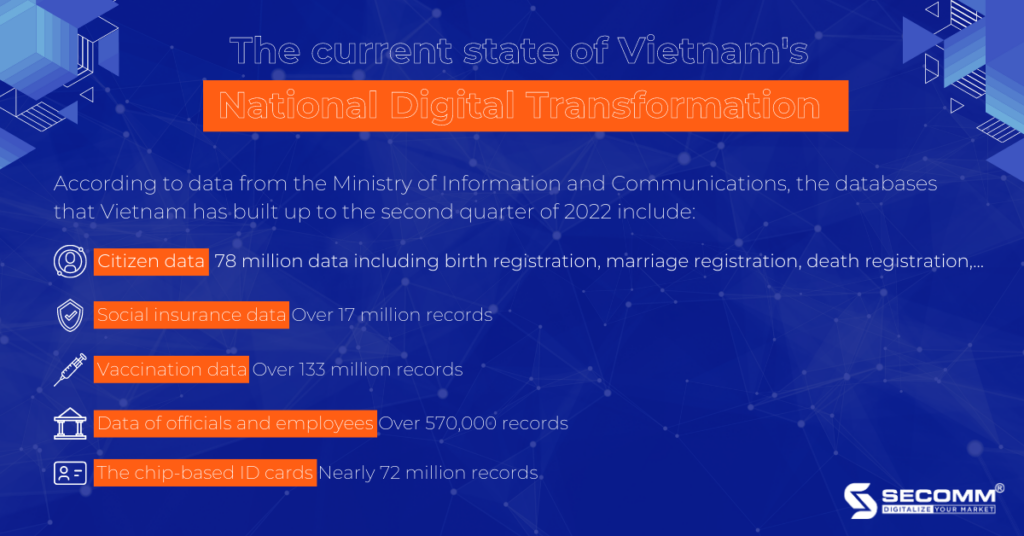
Additionally, the percentage of qualified online public services offered to individuals and enterprises has surpassed 97.3%; the percentage of these services that produce dossiers has gotten to 67.8% and the percentage of administrative procedures handled online has gotten to 43.2%.
Moreover, the economic sector has seen some very good improvements as a result of digital transformation. The Ministry of Information and Communications predicts that by the first quarter of 2022, the value of Vietnam’s digital economy will be 53 billion USD and that there would be 500 more newly founded digital technology businesses than there were at the same point in 2021.
The number of monthly users on Vietnamese mobile digital platforms climbed by more than 100 million compared to the same period in 2021, and the percentage of the digital economy in GDP increased to 10.41% in the first half of the year from 9.6% in the end of 2021.
Based on specific analysis and data on the situation of National Digital Transformation in Vietnam, it is clear that there are 3 main pillars that lay the foundation for the success of the National Digital Transformation process: Digital Government, Digital Economy, and Digital Society.
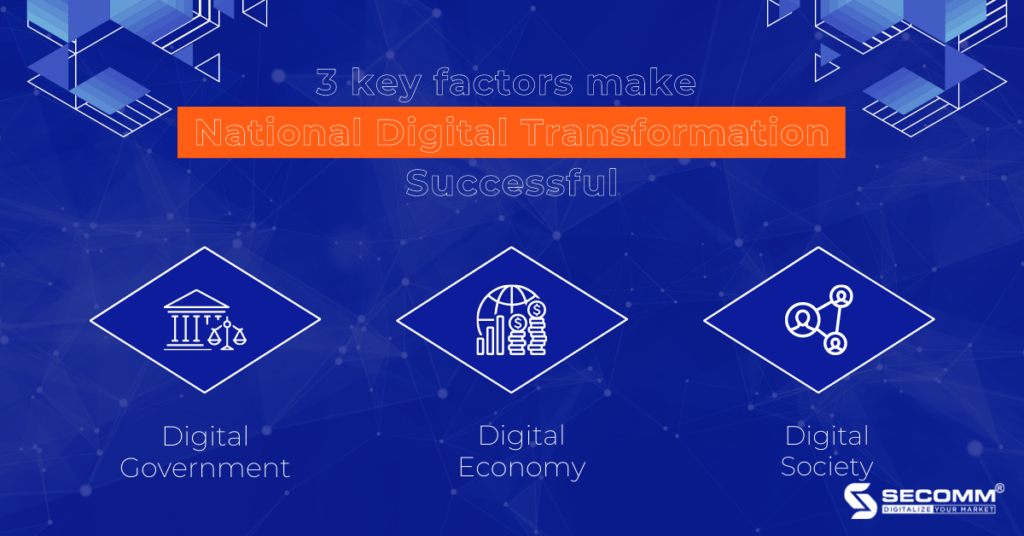
In order to increase operational efficiency and develop new operating models and alter the way services are offered using digital technology and data, a government must transition all of its operations to a digital environment. This allows enterprises to take part in the service delivery process. In other words, this is how the government is becoming digital.
Vietnamese citizens have been instructed in the past to finish the registration processes necessary to access the Citizen Identity Card with a chip, which is gradually replacing the previous ID card. This serves as one illustration of how well the digital government is progressing in Vietnam.
The process of processing dossiers and issuing ID Cards in the early stages is not really effective because the National Database on Civil is still under construction and staff training on how to use digital technology and digitize paper data on the data system is still limited. However, the procedure for issuing chip-based ID cards in addition to the cost is public and transparent.
As a result, when people arrive at the location where the chip-based ID card is made, processing will go more quickly if their information is already in the National Database; otherwise, they will need to provide more birth certificates and household registration information and will have to wait a long time for staff to check, enter data, and complete related procedures.
After that, the chip-based ID card will be sent to the registered address by post, but for the above reason, this process also takes quite a while.
The Public Service Portal of the Ministry of Public Security, however, is currently supported by the government and simply requires people to visit the location to capture pictures and fingerprints.
This demonstrates the government’s prompt responsiveness in streamlining business procedures while also saving time for both citizens and employees. This is evidence of the Government’s ongoing attempts to modernize itself digitally.
In addition, on the CCCD chip, more than 14 information fields of citizens are stored: (1) CCCD number; (2) Full name, other names; (3) Date of birth, month, and year; (4) Gender; (5) Nationality; (6) Ethnicity; (7) Religion; (8) Hometown; (9) Place of permanent residence registration; (10) Identification characteristics; (11) Date of issue; (12) Expiration date;
(13) Full name of parent, spouse; (14) issued 9-digit ID card number; (15) Portrait photos; (16) Features of fingerprint extraction and selection of two index fingers; backup for iris images, and other information.
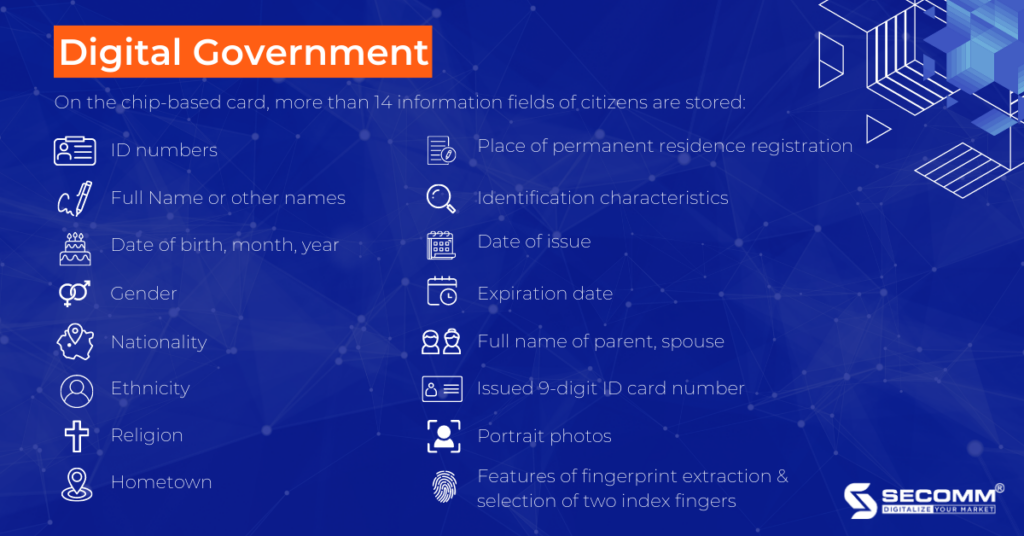
Moreover, a chip-based ID card can replace important papers such as Identity Cards, Health Insurance (HI), Social Insurance (Social Insurance), Birth Certificate, Marriage Certificate, and Household Registration Books….
It is clear that switching from conventional ID cards to chip-based ID cards has several advantages for both the general public and the government. People’s personal information is highly secure, preventing the creation of fake documents.
Also, ID cards with chips make paperwork and transactions straightforward because many pieces of crucial information are combined onto a single card, saving time and preventing the scenario where someone forgets to bring the necessary paperwork and causing the processing of documents to be interrupted.
The government made a wise choice by implementing chip-based ID cards.
The government can save, control, and check information about a specific individual quickly and efficiently with the use of chip-based ID cards and the National Database, helping to effectively control the situation of local security and order as well as national security.
Also, this helps free up labor for government employees who deal with people, handle paperwork, and maintain correctness, speed, and synchronization.
The second factor that makes the success of the National Digital Transformation process is the Digital Economy.
Digital Economy is an economy that maintains and develops constantly based on modern digital technology. The digital economy is also known as the Internet Economy, the New Economy, or the Web Economy. This particular economy is made up of electronic transactions over the internet.
According to the definition from the Vietnam Private Economic Forum, the digital economy is all economic activities based on digital platforms. Digital economy development is the use of digital technology and data to create a new model of cooperation and business, in line with the development trend of modern technology.
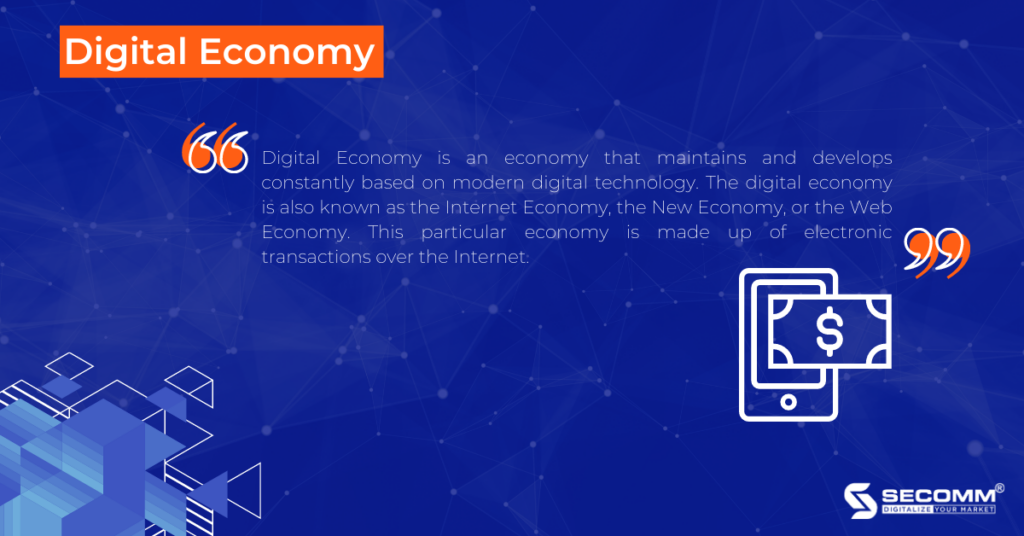
Therefore, everyone would immediately think of eCommerce when discussing the digital economy or the most prominent business model of the trend of digital transformation, and the strong push that this industry provides for high-volume industries catches the trend of digital transformation.
Few people anticipate that the conventional market model, which has become ingrained in Vietnamese culture, would soon be replaced by the market model 4.0, which accepts cashless payments. In several of Hai Phong’s traditional markets, this novel method of buying and selling was introduced for the first time, to the delight of the locals.
The Viettel Money application of Viettel Military Telecom Group, a pioneer in the digital transformation of market 4.0 models in 63 provinces/cities, enables all small businesses and individuals to purchase and sell things at the market by scanning QR codes or transferring money via phone number.
Moreover, cashless payment makes it easier for customers to shop at the market without worrying about issues like carrying change or budgeting extra cash for purchases. Also, many shopkeepers in the market are afraid of this issue pretty much.
Previously, if customers paid in cash with a denomination that was too big, shopkeepers would have to run everywhere to change money, causing time-consuming for both parties and other customers waiting to be served, the issue is now solved with just one smartphone.
Following the success of Hai Phong’s 4.0 market model, many other localities have also implemented this model and received positive feedback signals from the people such as Da Nang, Quang Ninh, Thai Nguyen, Lang Son, etc.
The market 4.0 model has spread to every nook and cranny of the nation’s small trading places, including farmers’ markets, grocery stores, sidewalk shops, amusement parks, parking lots, and more.
The digital transformation trend has quickly extended to places where it was previously impossible, helping to advance the digital economy and achieve the objective of a comprehensive national digital transformation.
Finally, the term “digital society” refers to all human activities in a broad sense. Digital technology, which is based on the exponential growth of information and data, is the primary driver behind digital society.
It transforms all facets of social structure, from the government and business to the individual. In a limited sense, “digital society” refers to both digital citizenship and digital culture.
From this perspective, the three pillars of a digital nation are the digital society, the digital government, and the digital economy.
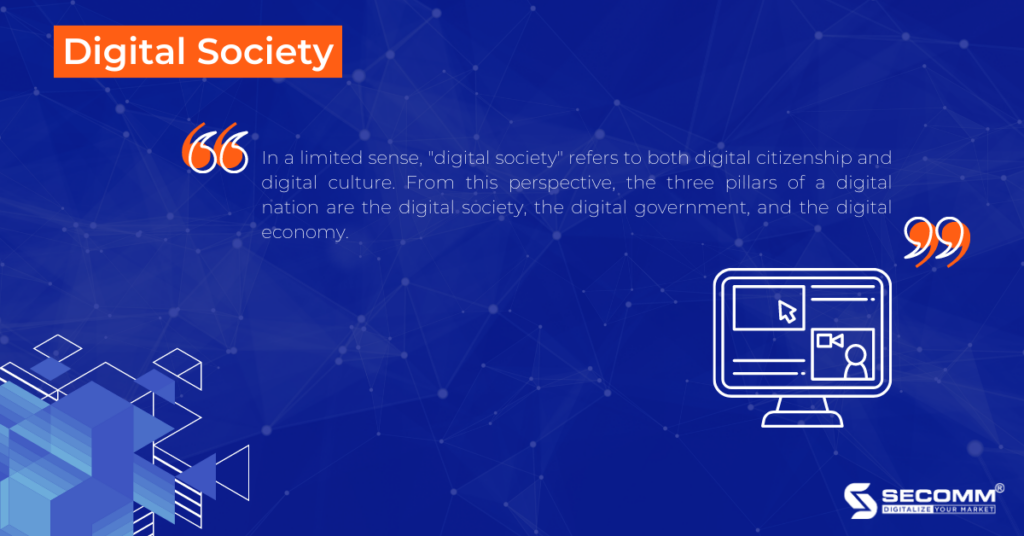
Teachers, parents, and students all adore the eLearning model, which is developing into a popular teaching and learning trend, especially in light of the recent pandemic and widespread implementation of social distancing policies.
Students can access lessons at any time, studying at home, using simply an electronic device with an Internet connection. As a result, teachings can be discussed and interacted with by professors and students without them having to actually meet.
This model also supports student doing teamwork well because it is not time- or space-constrained, saving on travel expenses in addition to using many other helpful resources.
However, for eLearning to really replace traditional teaching and learning methods, it takes a lot of effort from both the Government, the school system, and the student’s parents.
In fact, eLearning is only a small part of the digital society effort besides many other important aspects of society that need to be digitally transformed to make life more convenient for people.
National Digital Transformation has become one of Vietnam’s top goals and this is also a rare project that has received special attention from the highest levels of leadership and international support. Since then, Vietnam has had a full foundation to hope to realize the goal of becoming a digital country from now to 2030.
The development of a digital society, economy, and government, in particular, is a necessary and sufficient condition for a successful national digital transformation.
In fact, every citizen, from intellectuals to regular citizens, is gradually demonstrating a certain understanding in their own way about the digital transformation and awareness that the country is in a transition period to match the general development trend of the times.
This is in addition to the efforts of businesses and the support from the government.
Especially for businesses, digital transformation is an imperative remedy to withstands to withstand the tsunami of eradication brought on by the pandemic’s rapid shift in new business patterns.
Following Covid-19, business digital transformation flowed slowly, gently, and steadily, assisting the economy’s continued rotation.
The first step of the digital transformation journey for businesses is to start implementing eCommerce.
With many years of experience in successfully implementing eCommerce for many customers in many countries, SECOMM specializes in providing consulting services with comprehensive and professional eCommerce implementation solutions.
Contact SECOMM today for free support and advice.
 2
2
 4,084
4,084
 0
0
 1
1
The market is the foundation for creating a business’s original values, deciding essential requirements and conditions a business needs to achieve to enter the stage of market presence. From then, customers with specific demands will choose to buy the items they want. The ultimate goal of a market is to meet the needs of commodity exchanges precisely. This process continuously compels businesses to maintain and update their business operations, immediately adapting to customer requirements and not falling behind other competitors in the same market.
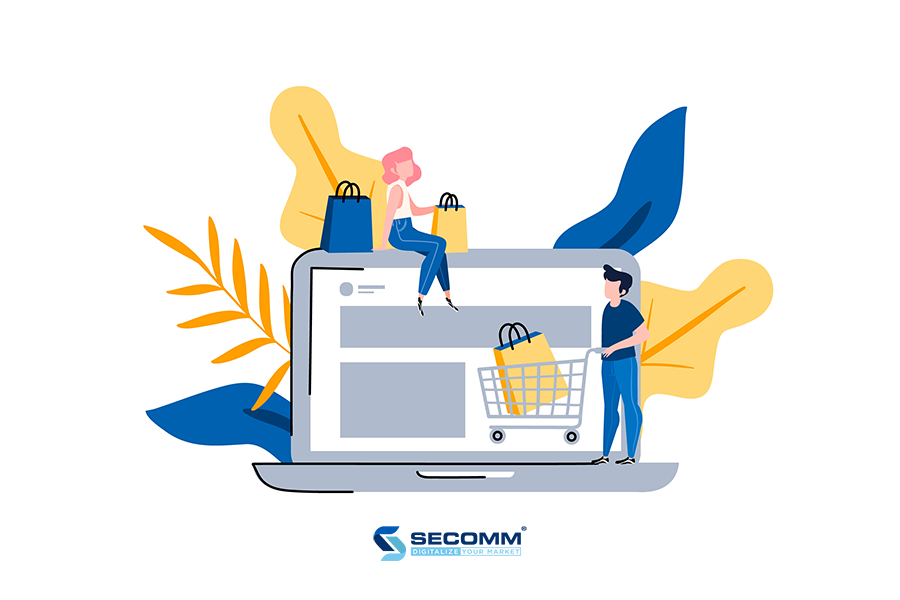
The market helps businesses approach customer behaviors more deeply, which is very important in resource management. That also presents in data sources such as the number of selling goods, rising goods consumption, or figures showing a sharp drop in merchandise sales due to the disease’s impact. These factors will contribute to the next analysis steps from collected data, approach the operation process more accurately, simultaneously regulate the level of goods production to meet just enough customer needs, avoid goods-excess or -shortage.
A market will reflect the competitiveness, scale, and position of all businesses within the market-share concept. Determining market share will point out precisely the revenue dimension compared to other competitors, also contribute to research and development activities, clearly identify competitors, customers, strengths, weaknesses, and at the same time, aim for following strategies to improve or increase sales.
Under the control and dominance of a market, businesses also contribute their values to the general development custom, creating different development orientations and characteristics for each market type.
The competition among businesses promotes a much more vibrant market. It is also the driving force for enterprises to change and perfect day-to-day operating systems, update the trend not to fall behind other similar competitors, and finally optimize the customer experience.
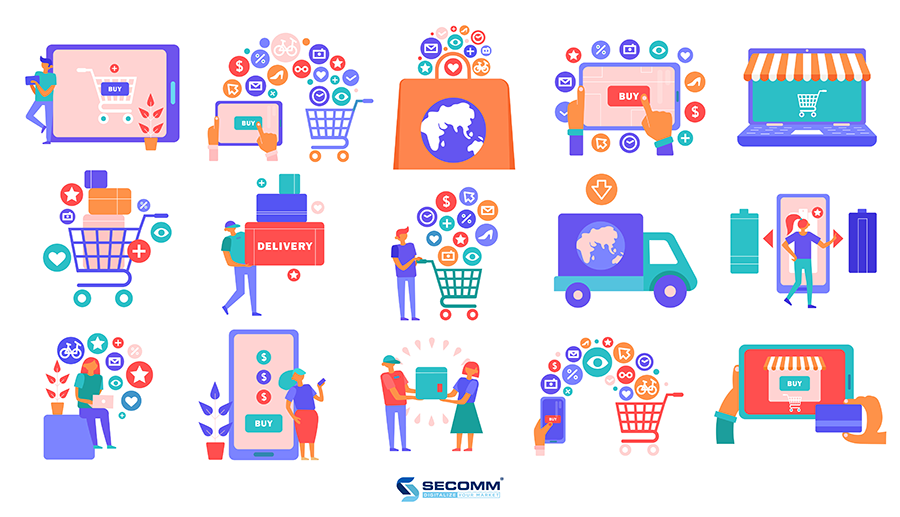
Business growth expands the market dimension and stability. A speedily growing business will supply more substantial quantities of goods, focusing on research and improving goods quality. This approach will attract more potential customers; also new companies. The full penetration of market factors (sellers and buyers) concurrently affects the market size compared to a general economic picture.
Over 50% of companies are aware of the impact of the Industrial Revolution 4.0 and feel it is taking place day by day. However, more than 70% of businesses do not fully understand their technology systems’ status and have yet to ascertain where and when to start deploying digital transformation.
While many other companies have quickly grasped and implemented digital transformation strategies for a long time and achieved specific success in the market, most of the remaining companies struggled with financial and technological problems. That contrary also affects the market, makes it move slowly and miss technology updates. Therefore, to successfully digital-transform, the interactions between market and business should not be overlooked.

First, market and business must satisfy the fundamentals of digital transformation, including connectivity and a stable internet platform. Connectivity refers to connection size and speed. Connection needs will increase continuously in the future, allowing businesses and markets to ignore their customer networks’ connections.
Next, the connection speed needs to be improved to help data transmission and processing take place faster. Since ecommerce sites have become more and more popular, customers have more options when shopping, and there is no reason to waste time waiting for a too slow-speed website. That is why the Internet platform is a vital imperative requirement to promptly meet the needs of markets, businesses, and users in the digital age. The Internet has become an essential part of daily life and a cornerstone facilitating the digital transformation process, promoting innovation, creativity, and new technology applications to the existing civilization.
Besides, focusing attention on improving digital skills for human resources is also a way to tighten the interactions between market and business. Digital transformation tends to impact old business models to upgrade and improve them into leaner and much more modern models. That prediction significantly affects human resources when some jobs have been automated and operated by artificial intelligence without humans. However, these automation jobs can produce more brand-new alternative jobs, namely quality management, market research and development, and product development.
Nevertheless, at the same time, it also raises the requirement to improve the capacity and digital skills of all existing human resources. Information technology skills have gradually become an essential condition for each individual to fully meet the labour market’s basic needs, especially when ecommerce becomes a trend worldwide. However, the ecommerce market also needs to improve data security issues, logistics, and payment security to gain the highest trust from customers and further development in the future.
The interactions between market and business are often subject to significant impacts from common development tendencies, technological advancements, and other digital transformation issues that make sense to be continuously updated and changed procedures to suffice customer needs and experience. Within those interactions, businesses will perform digital transformation responsibilities from the market requirements and vice versa; the market is the environment showing the exact business outcomes. When having reached the capacity and position, businesses can create a different market themselves with a stable and sustainable customer source.
 2
2
 6,668
6,668
 1
1
 1
1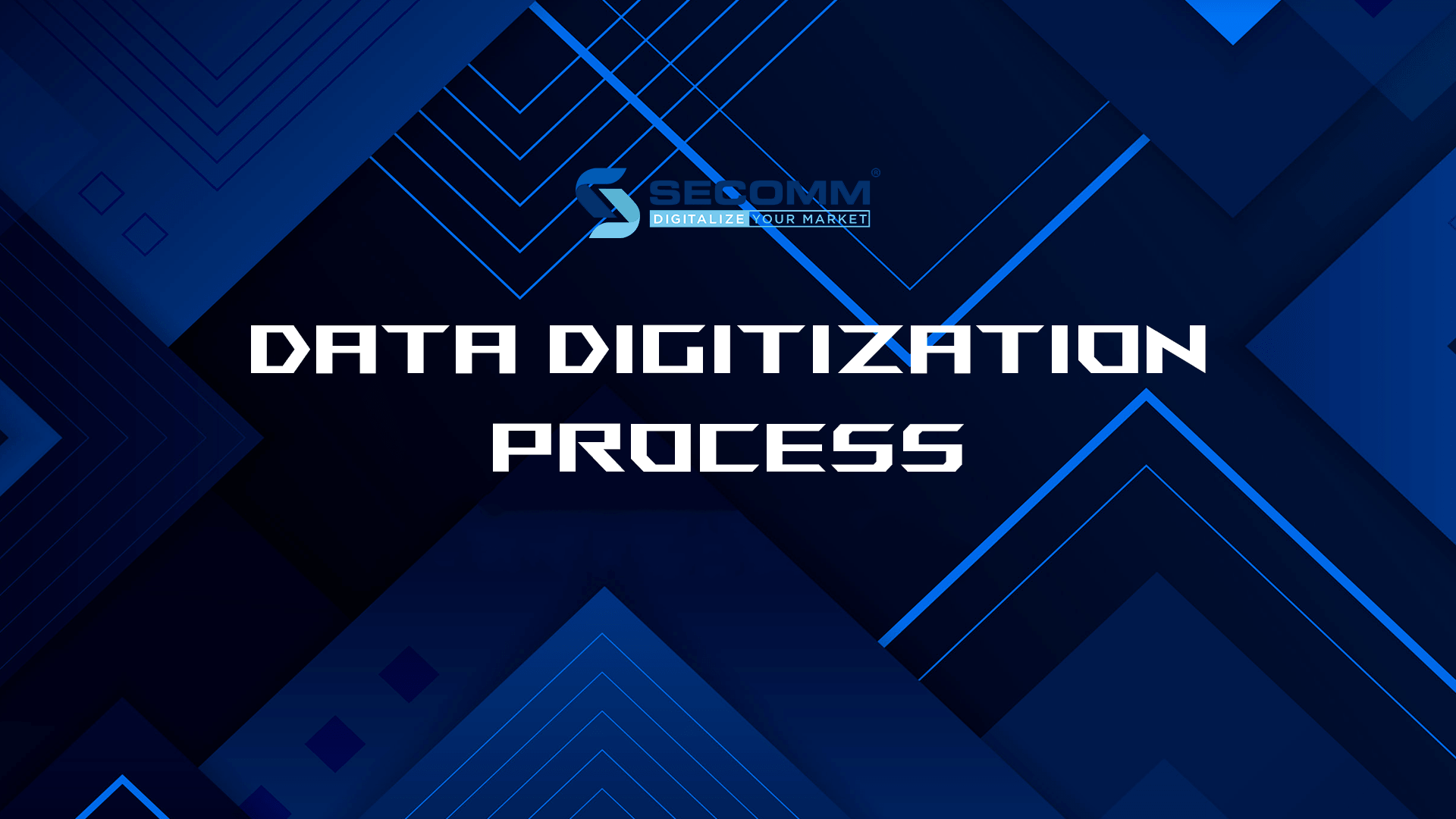
Data digitization is a data-transforming process from traditional paperwork to digital format databases. After digitization comes to completion, the database will be stored and managed by software or technology platforms, enhancing this data system’s security and accessibility.
This enhancement is an obligatory transformation requirement for traditional business models as most businesses face operational and management problems. At the same time, start-ups already can access new technologies and have a more modern changing mindset.
First things first, there are many difficulties in storing and preserving paper-printed documents. They are often bound to form in book-types with large sizes. Secondly, paperwork makes searching, synthesizing, and analyzing unnecessary time-consuming.
Meanwhile, digital data sources can streamline the bulk of previous paperwork while still having enough digital space to store in the data systems. Those systems especially have many advantages about security and flexibility in supporting data analysis and research for business development strategies.
An essential data digitization process goes through 3 main stages: data classification, format conversion, storage, and management.
To fully prepare for a digital data plan, businesses can start by sorting and sifting through document types according to digitalization objectives and strategies. Specifically, retailers can prioritize the data of products, inventory, customer information, or ordering reports. Besides, operating-oriented businesses may consider using internal data sources for in-house working and managing processes such as accounting data, factory data, operating records, and other related types.

In the next conversion step, paper documents will be scanned and converted to image sources such as JPG, TIFF, GIF, PNG, RAW… With a much more improved budget, an organization can take advantage of more breakthrough technologies, namely AI, Machine Learning, Big Data… to digitize paper-printed data into editable formats. The data will then become streamlined and stored in data systems for the later exploiting and editing objectives.
The benefits of digital data management systems are the minimization of storing space and cost, access time, operation, and management costs, simultaneously providing the optimization of security and data mining performance. These systems operate under two main requirements: the first is to store, the second is to support data access flexibly and quickly.
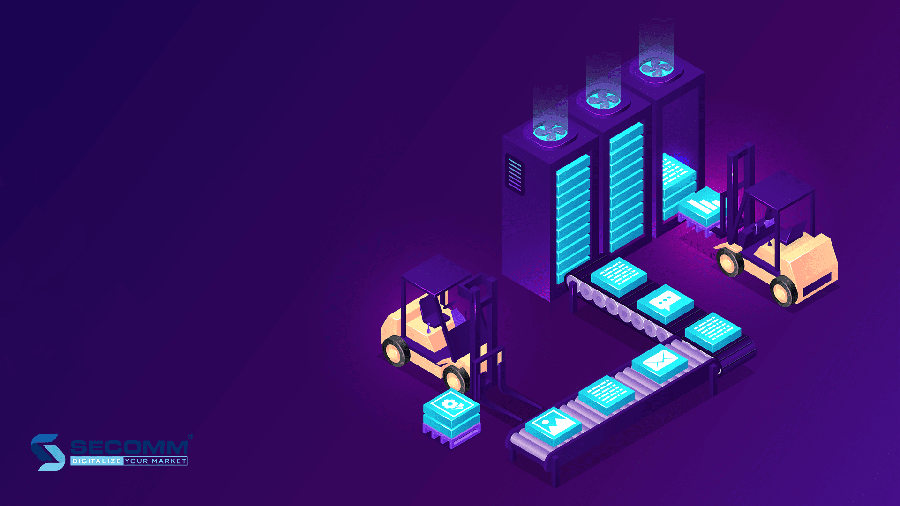
One of the essential tasks is to use the right technology at a particular milestone to optimize the process’s quality and time. When matching both the above requirements, businesses no longer need to worry about the budget-exceeds anymore.
Solutions for data digitization processes will be much more comprehensive by using digital data management systems tailored to the data storage and access needs. Businesses also easily use data for business research and development objectives, improve products, service quality, or produce brand-new products and services to meet customer demands. Essentially, digital data management systems can:
One of the most popular digital data management platforms is ERP systems. ERP contributes to being an entire enterprise management system capable of using data as a business operation resource.

In particular, ERP creates a high-logical storage arrangement for all business departments to develop the ability to seamlessly and quickly access, usage, and exploit information. However, ERP is a comprehensive transformation that requires businesses to accept innovation significantly and reform the traditional operating model.
Data digitization can also be effectively applied in national public services, forming e-government to transform the traditional administrative environment’s working process. E-government creation brings a massive advantage for both the government and the citizens when managerial procedures become faster and more flexible.
Also, information and data sources in the electronic management environment are more secure, safe, and transparent. A typical example of this strength is the blockchain application in managing the e-tax system of an enterprise. Blockchain possesses a significant advantage in data security, and value-added tax transactions are also real-time done quickly, minimizing fraud and tax evasion.
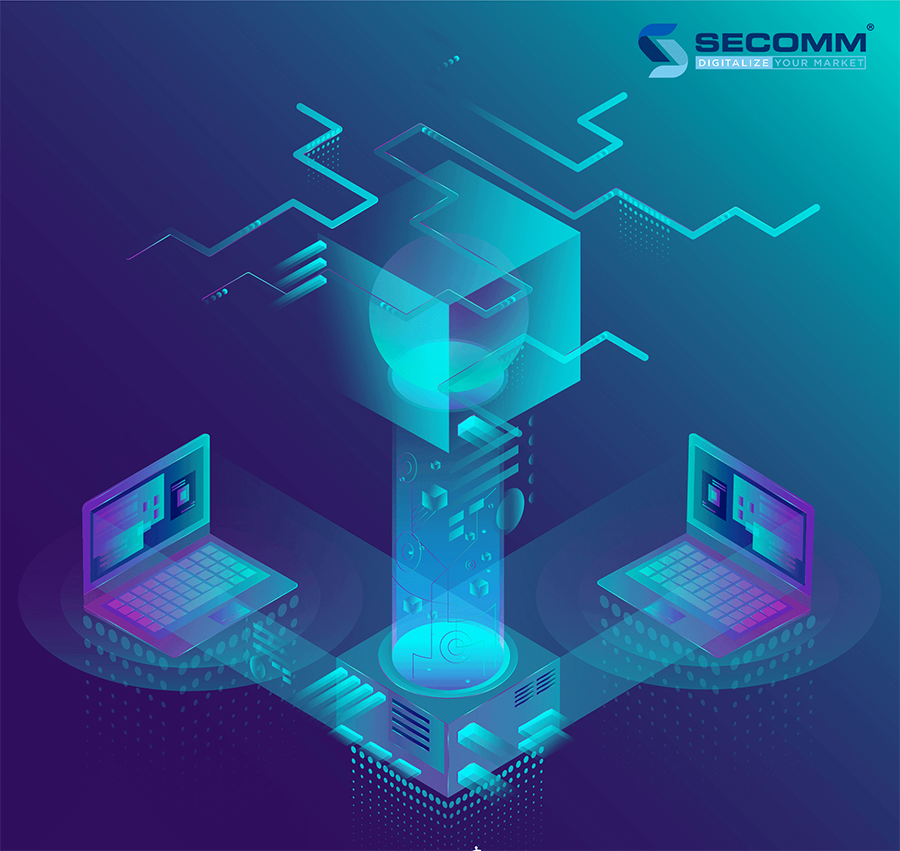
Another data digitization case study is the accelerated development of retail technology applications by Saigon Co.op. With the most astounding purpose of optimizing the customer experience, this retailer aims to partner with leading technology businesses to create a digital shopping space.
As a result, the cooperation with Momo wallet has got implementation, and the brand has become the principal e-payment method in supermarkets. The combination with the Grab delivery system is also an essential breakthrough, promising GrabExpress freight forwarding services and food delivery GrabFood applied to the entire structure of Co.opmart, Co.opXtra in Ho Chi Minh City.
However, these successful case studies in typical pioneers’ digitization process do not mean that formula will bring absolute success for almost all businesses. Data digitization strategies mostly depend on external factors. They are even contingent on business demands. That is the reason why companies need to tailor standard processes and systems before conducting data digitization.
Digital transformation is an essential process of multiple scales, in which digitization is only a small layer. However, this layer is a critical core value of the whole digital transformation process.
Data digitization gives businesses many significant advantages to meet the digital transformation process’s basic requirements, converting the format of data platforms. Forms of storing and managing data are also quite diverse, and businesses can choose the right way to manage their digital data sources.
However, technology is not the main factor for success, so is multiple platforms usage. Considering the correct strategies, data systems based on appropriate technology platforms will lead businesses closer to expected results.
 2
2
 7,011
7,011
 2
2
 1
1Subscribe to get the latest eBook!
Hotline